SEO
Top 7 SEO Keyword Research Tools For Agencies
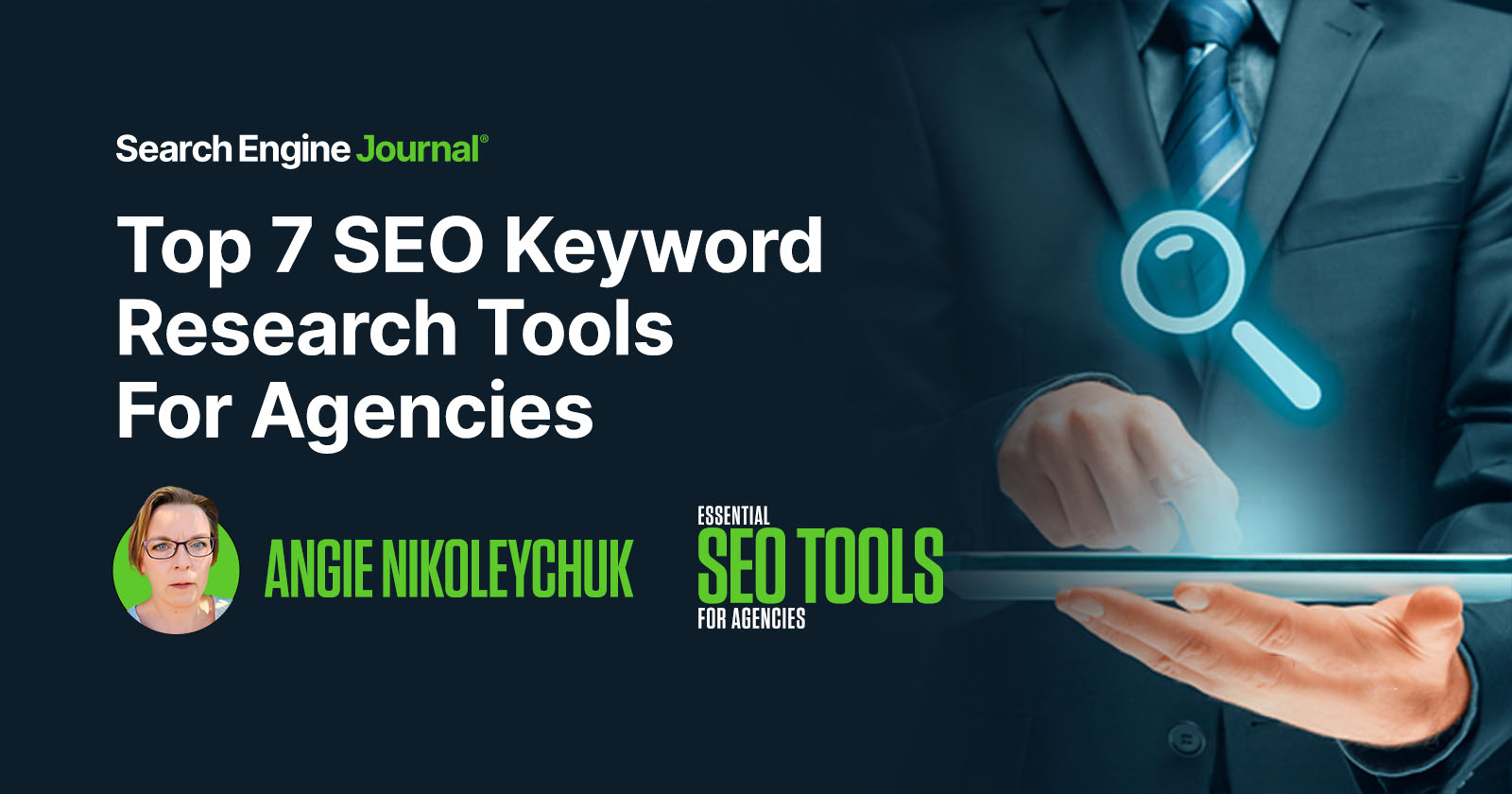
All successful SEO campaigns rely on accurate, comprehensive data. And that process starts with the right keyword research tools.
Sure, you can get away with collecting keyword data manually on your own. But while you may be saving the cost of a premium tool, manual keyword research costs you in ot
her ways:
- Efficiency. Doing keyword research manually is time intensive. How much is an hour of your time worth?
- Comprehensiveness. Historical and comprehensive data isn’t easy to get on your own. It’s too easy to miss out on vital information that will make your SEO strategy a success.
- Competition. Keyword research tools allow you to understand not only what users are searching for but also what your competition focuses on. You can quickly identify gaps and find the best path to profitability and success.
- Knowledge. Long-time SEO experts can craft their own keyword strategies with a careful analysis of the SERPs, but that requires years of practice, trial, and costly errors. Not everyone has that experience. And not everyone has made enough mistakes to avoid the pitfalls.
A good SEO keyword research tool eliminates much of the guesswork. Here are seven well-known and time-tested tools for SEO that will get you well on the way to dominating your market.
1. Google Keyword Planner
Cost: Free.
Google Keyword Planner is a classic favorite.
It’s free, but because the information comes directly from the search engine, it’s reliable and trustworthy. It’s also flexible, allowing you to:
- Identify new keywords.
- Find related keywords.
- Estimate the number of searches for each variation.
- Estimate competition levels.
The tool is easy to access and available as a web application and via API, and it costs nothing; it just requires a Google Ads account.
You must also be aware of a few things when using this tool.
First, these are estimates based on historical data. That means if trends change, it won’t necessarily be reflected here.
Google Keyword Planner also can’t tell you much about the SERP itself, such as what features you can capitalize on and how the feature converts.
Because it’s part of Google Ads, PPC experience can help you gain more insights. You’ll find trends broadly across a demographic or granular level, like a city, region, or major city.
Google Keyword Planner also tends to combine data for similar keywords. So, if you want to know if [keyword near me] is better than [keywords near me], you’ll need a different tool.
Lastly, the tool uses broad definitions of words like “competition,” which doesn’t tell you who is ranking for the term, how much they’re investing to hold that ranking, or how likely you are to unseat them from their coveted top 10 rankings.
That being said, it’s an excellent tool if you just want to get a quick look or fresh ideas, if you’d like to use an API and create your own tools, or simply prefer to do the other tasks yourself.
2. Keyword.io
Cost: Free, $29 per month, and $49 per month.
If Google’s Keyword Planner isn’t quite enough, but you’re on a tight budget, Keyword.io may be the alternative you need. It also has different features.
Keyword.io uses autocomplete APIs to pull basic data for several sites and search engines, including Google, Amazon, eBay, Bing, Wikipedia, Alibaba, YouTube, Yandex, Fiverr, and Fotolia. This is perfect for niche clients and meeting specific needs.
It also has a Question/Intent Generator, an interactive topic explorer, and a topical overview tool.
In its user interface (UI), you’ll find an easy-to-use filter system and a chart that includes the competition, search volume, CPC, and a few other details about your chosen keywords.
It does have some limits, however.
You can run up to 20,000 keywords per seed with a limit of 100 requests per day (five per minute) or 1,000 requests per day (10 per minute) on its paid plans.
Its API access, related keywords tool, Google Ad data, and other features are also limited to paid accounts.
3. Semrush
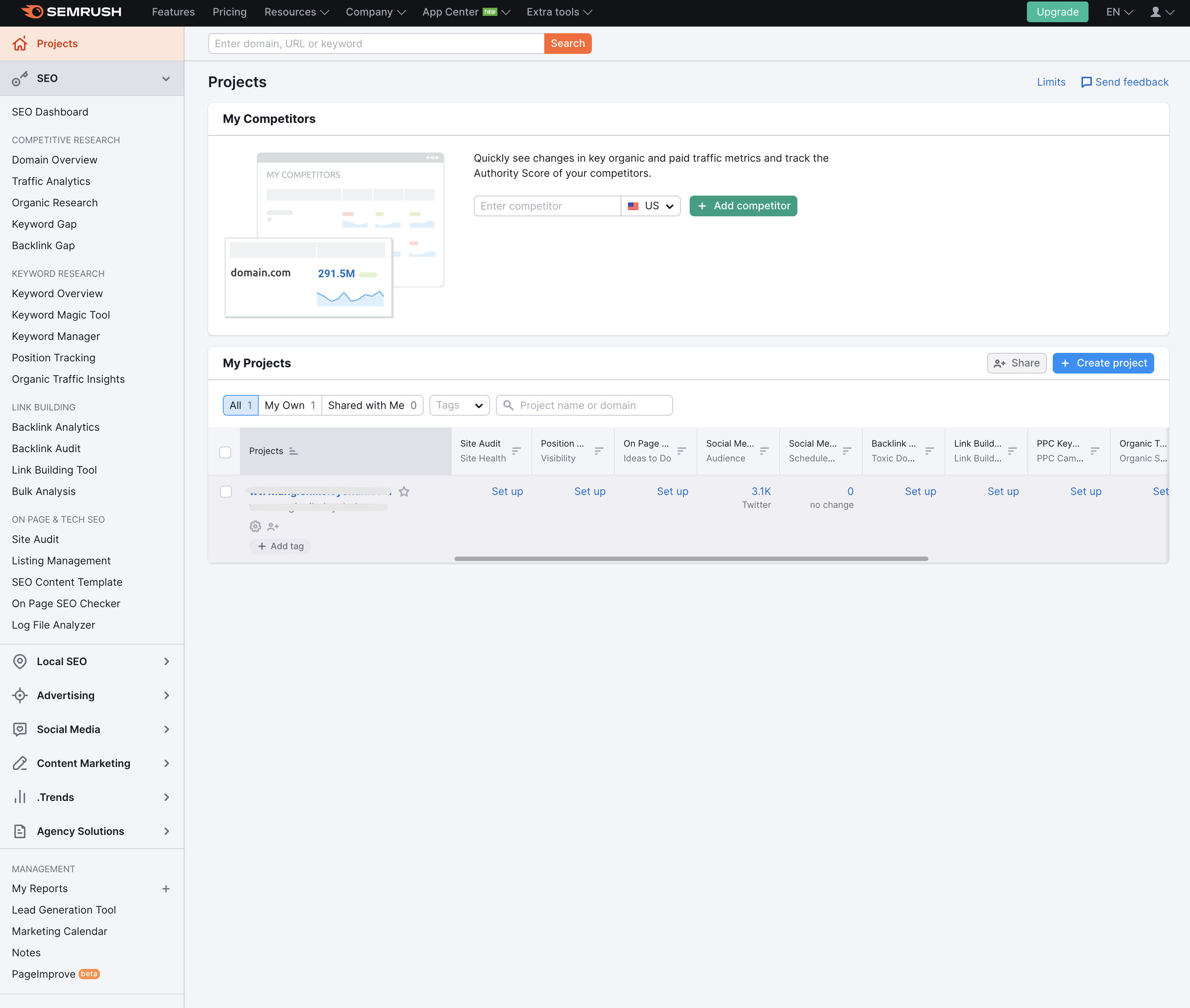 Screenshot from Semrush
Screenshot from SemrushCost: $119.95 to $449.95 per month.
In its digital marketing suite, Semrush offers a collection of six keyword tools and four competitive analysis tools with a database of more than 21 billion keywords.
You can get a full overview of the keywords you’re watching, including paid and organic search volume, intent, competition, CPC, historical data, SERP analysis, and more.
You’ll get related keywords and questions, as well as a ton of guidance, ideas, and suggestions from the Semrush Magic, Position Tracking, and Organic Traffic Insights tools.
The Keyword Planner, however, is where much of the magic happens.
The organic competitor tab makes it easy to spot content and keyword gaps. Expand them and develop clusters that will help you grab traffic and conversions.
You can also see long-tail keyword data and other data to see what Page 1 holds regarding competition, difficulty, and opportunities at a broad or hyperlocal level.
The full suite of tools is a huge benefit. Teams can collaborate, share insights, and plan.
The seamless integration allows you to integrate your data, meaning teams can easily collaborate, share insights, and strategize.
And when you’re done, it can track everything you need for a successful digital marketing strategy.
Some of the tools they offer include:
- On-page SEO tools.
- Competitive analysis suite.
- Log file analysis.
- Site auditing.
- Content marketing tools.
- Marketing analysis.
- Paid advertising tools.
- Local SEO tools.
- Rank tracking.
- Social media management.
- Link-building tools.
- Amazon marketing tools.
- Website monetization tools.
Semrush’s best features when it comes to keyword research are its historical information and PPC metrics.
You can deep dive into campaigns and keywords to unlock the secrets of the SERPs and provide agency or in-house teams with priceless information they don’t usually access.
4. Moz Keyword Explorer
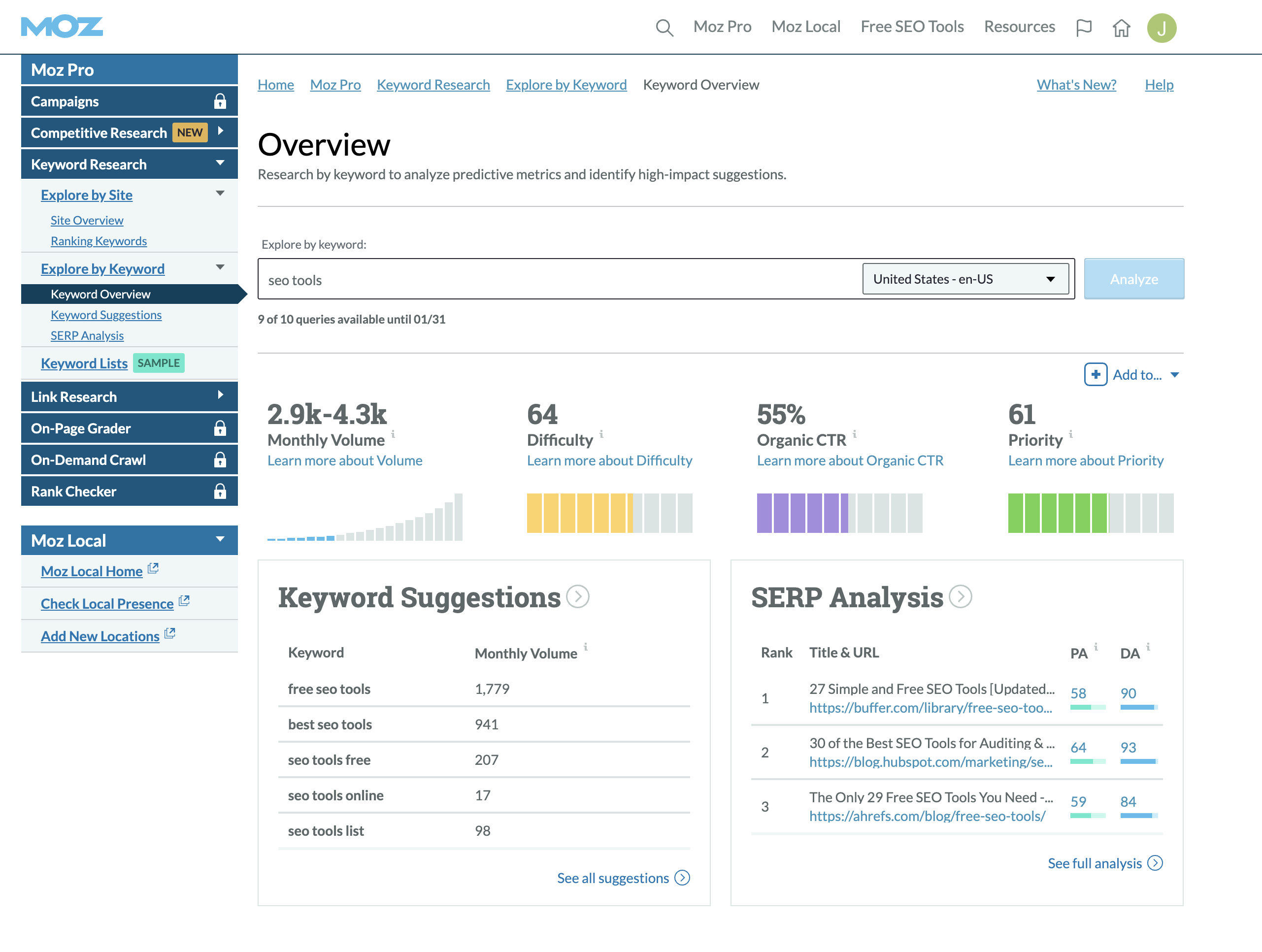 Screenshot from Moz, January 2023
Screenshot from Moz, January 2023Cost: Free for 10 queries per month. $99-$599 per month.
With a database of more than 500 million keywords, Moz Keyword Explorer may be a great option if you’re looking to build a strategy rather than get a quick view of the data for a few keywords.
Moz has long been a leader in the SEO space.
Constantly updating and improving its Keyword Explorer Tool and its other core services, Moz keeps up with the trends and is well known for providing SEO professionals with the latest tools. And it has done so for more than a decade.
Like the Google Keyword Tool, Moz’s keyword planning tool provides information on the difficulty and monthly search volume for terms. It also lets you drill down geographically.
When you start, you’ll find the Keyword Overview, which provides monthly search volumes, ranking difficulty, organic click-through opportunities, and an estimated priority level.
You can also:
- Find new relevant keywords you should be targeting but aren’t.
- Learn how your site performs for keywords.
- Find areas where you can improve your SEO (including quick wins and larger investments).
- Prioritize keywords for efficient strategy creation.
- Top SERP analysis and features.
- Competitor analysis.
- Organic click-through rates.
Unlike the Google Keyword Tool, however, Moz supplies you with data beyond the basics. Think of it like keyword research and SERP analysis.
Moz does tend to have fewer keyword suggestions. And like Google’s Keyword Planner, it provides range estimates for search data rather than a specific number.
However, the database is updated frequently, so you can feel confident that you’re keeping up with the constant change in consumer search habits and rankings.
Plus, it’s easy to use, so teams can quickly take care of marketing tasks like finding opportunities, tracking performance, identifying problem areas, and gathering page-level details.
Moz also offers several other tools to help you get your site on track and ahead of the competition, but we really like it for its keyword research and flexibility.
5. Ahrefs Keyword Explorer
Cost: $99-$999 per month.
If I had to describe Ahrefs in one word, it would be power.
Enter a word into the search box, and you’re presented with multiple panels that can tell you everything you want to know about that keyword.
Total search volume, clicks, difficulty, the SERP features, and even a volume-difficulty distribution. And while it may look like a lot, all the information is well-organized and clearly presented.
Ahrefs provides terms in a parent-child topic format, providing the terms with context, so you can easily learn more about the terms, such as intent, while identifying overlap and keeping it all easy to find and understand.
These topics appear when you search for a related term, including the term’s ranking on the SERP, SERP result type, first-page ranking difficulty scores, and a snapshot of the user-delivered SERP. You can stay broad or narrow it all down by city or language.
Ahrefs can get a bit expensive. Agencies may find it difficult to scale if they prefer several user or client accounts, but it’s still one of the best and most reliable keyword research tools on the market.
What I really like about Ahrefs is that it’s thorough. It has one of the largest databases of all the tools available (19.2 billion keywords, 10 search engines, and 242 countries at the time of writing), and it’s regularly updated.
It makes international SEO strategies a breeze and includes data for everything from Google and Bing to YouTube and Amazon.
Plus, they clearly explain their metrics and database. And that level of transparency means trust.
Other tools in the suite include:
- Site Explorer.
- Site auditing.
- Rank tracking.
- Content Explorer.
6. SERanking
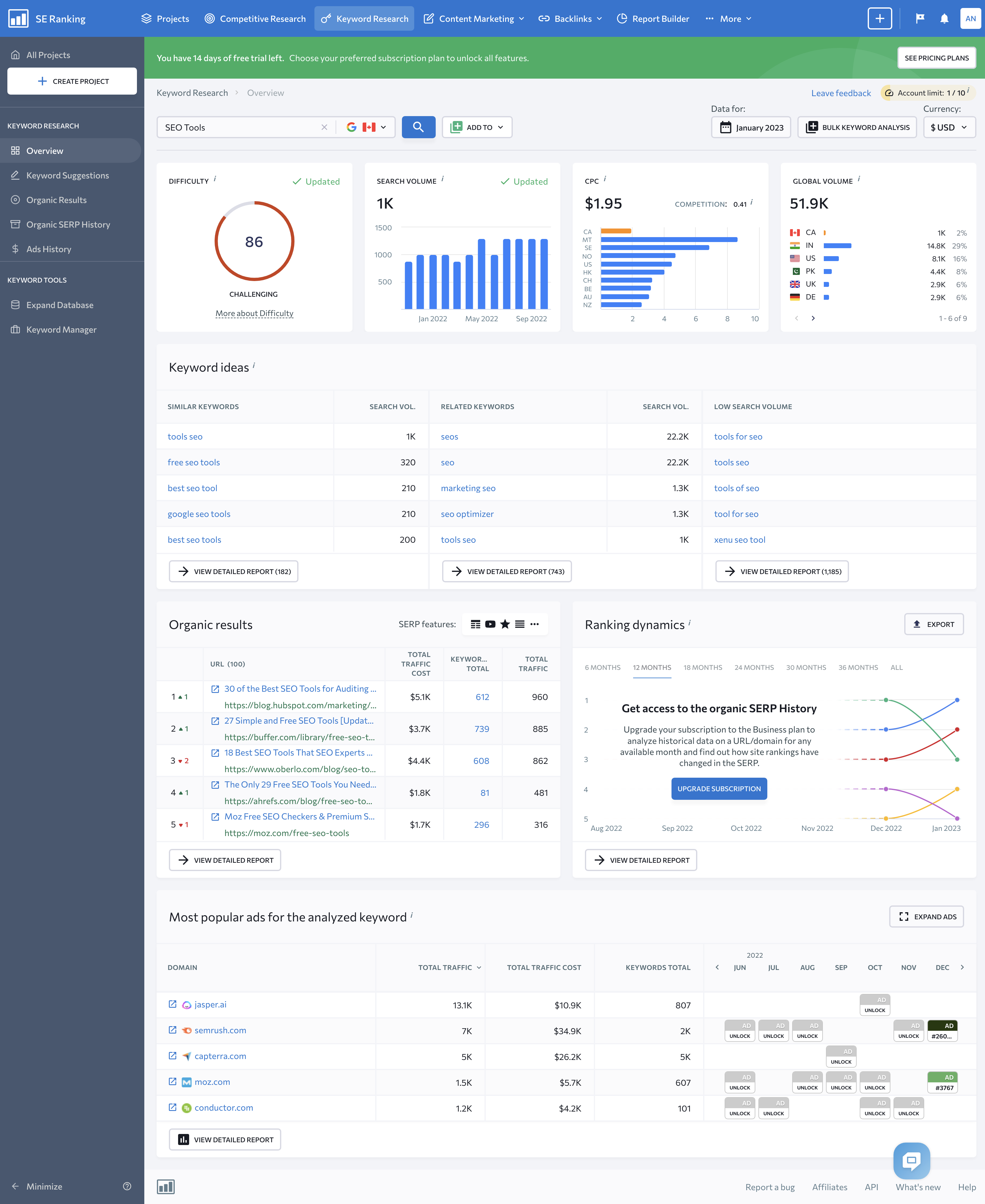 Screenshot from SERanking, November 2022.
Screenshot from SERanking, November 2022.Cost: $23.52-$239 per month, depending on the ranking check and payment frequency.
SERanking shines as a keyword research tool within an all-around SEO toolkit. SERanking helps you keep costs down while offering features that allow agencies to meet clients’ unique needs.
One of the first things you’ll notice when you log in is its intuitive user interface. But this tool isn’t just another pretty online tool.
Its database is robust.
SERanking’s U.S. database includes 887 million keywords, 327 million U.S. domains, and 3 trillion indexed backlinks. And this doesn’t include its expansive European and Asian databases.
The overview page provides a solid look at the data, which includes search volume, the CPC, and a difficulty score.
SERanking also provides lists of related and low-volume keywords if you need inspiration or suggestions, as well as long-tail keyword suggestions with information about SERP features, competition levels, search volume, and other details you need to know to identify new opportunities.
Of course, identifying keywords is only the start of the mystery. How do you turn keywords into conversions? SERanking provides keyword tools that help you answer this question.
You can find out who the competition is in the organic results and see who is buying search ads, as well as details like estimated traffic levels and copies of the ads they’re using.
This allows you to see what’s working, gain insights into the users searching for those terms, and generate new ideas to try.
SERanking offers agency features, such as white labeling, report builders, lead generator, and other features you’ll find helpful.
However, one of the features agencies might find most helpful in keyword research is SERanking’s bulk keyword analysis, which lets you run thousands of keywords and download full reports for all the terms that matter.
Other tools in the SERanking Suite include:
- Keyword Rank Tracker.
- Keyword Grouper.
- Keyword Suggestions and Search Volume Checker.
- Index Status checker.
- Backlink Checker.
- Backlink monitoring.
- Competitive research tool.
- Website auditing tool.
- On-page SEO Checker.
- Page Changes Monitor.
- Social media analytics.
- Traffic analysis.
SERanking is more affordable than some of the other tools out there, but it does come at a cost.
It isn’t as robust as some of its competitors and doesn’t get as granular in the same way, but it still provides the features and data you need to create a successful SEO strategy.
And with its flexible pricing, this tool is well worth considering.
7. BrightEdge Data Cube
Cost: Custom pricing model.
If you’re looking for an AI-powered digital marketing tool suite that includes a quality research tool, BrightEdge may be the right option for you.
Unlike other tools that focus on supplying you with data and ways to analyze that data, BrightEdge looks to do much of the time-consuming analysis for you.
Among its search, content, social, local, and mobile solutions, you’ll find Data Cube – an AI-backed content and keyword tool that uses natural language processing to find related topics and keywords.
You’ll also encounter DataMind, an AI that helps you find search trends, changes in consumer behaviors, and important competitor movements you need to know about.
The two together make it quick and easy to perform keyword research, build out topics, create content strategies, and strengthen your SEO plans.
Once you enter a topic or broad keyword, the tool will provide you with relevant keywords, the search volume, competition levels, keyword value, it’s universal listing, and the number of words in the phrase.
Filter the results by a custom set of criteria to narrow the list down and get the necessary information.
Once you have a list, select the ones you want to keep and download them or use them with BrightEdge’s other tools to create full strategies and gain more insights.
This could include competitor analysis, analyzing SERP features, intent, or other tasks.
For agencies that provide local SEO, BrightEdge also offers HyperLocal, which helps you find and track keywords and keyword performance at the local level.
When you’re done, give the Opportunity Forecasting and tracking tools a try to monitor your progress and provide clients with the information they care about.
Perhaps the nicest feature for agencies is its Storybuilder – a reporting tool that allows you to create rich client reports that provide clients with targeted overviews and the data they’re most interested in.
If this sounds like the right tool for you, the company gives demos, but there are a few things you should consider.
First, it only updates once per month. And while the company keeps its pricing close to the chest, this digital marketing tool suite is a significant investment. It may not be the best choice if keyword research is the only thing you need.
Secondly, while the tools are highly sophisticated and refined, there is a learning curve to get started.
You’ll also discover that there are limits on features like keyword tracking, and it can be time-consuming to set up, with some adjustments requiring technical support.
Lastly, BrightEdge’s keyword research tool doesn’t let you get too far into the weeds and doesn’t include PPC traffic.
That aside, agencies and larger brands will find that it scales easily, has a beautifully designed UI, and makes you look great to clients.
The Best Agency SEO Keyword Research Tools
This list only contains seven of the many tools available today to help you get your keyword research done to an expert degree.
But no matter how many of the tools we share with you or which ones, it’s important to understand that none are flawless.
Each tool has its own unique strengths and weaknesses, so selecting a platform is very much dependent on the types of clients that you typically work with and personal preference.
In reality, you’ll likely find that you prefer to work between a few tools to accomplish everything you’d like.
Google Keyword Planner and Keyword.io are top choices when you want a quick look at the data, or you’d like to export the data to work on elsewhere. You may even want to use this data with the other tools mentioned in this chapter.
Ahrefs, Moz, Semrush, and BrightEdge are far more robust and are better suited to agency SEO tasks.
While not free (although they offer free plans or a trial period except BrightEdge), they allow you to really dig into the search space, ultimately resulting in higher traffic, more conversions, and stronger SEO strategies. These benefits require more time and often come with a learning curve.
By far, the most important keyword research tool you have access to is you.
Keyword research is more than simply choosing the keywords with the biggest search volume or the phrase with the lowest Cost Per Click (CPC).
It’s your expertise, experience, knowledge, and insights that transform data into digital marketing you can be proud of.
Featured Image: Paulo Bobita/Search Engine Journal
SEO
56 Google Search Statistics to Bookmark for 2024
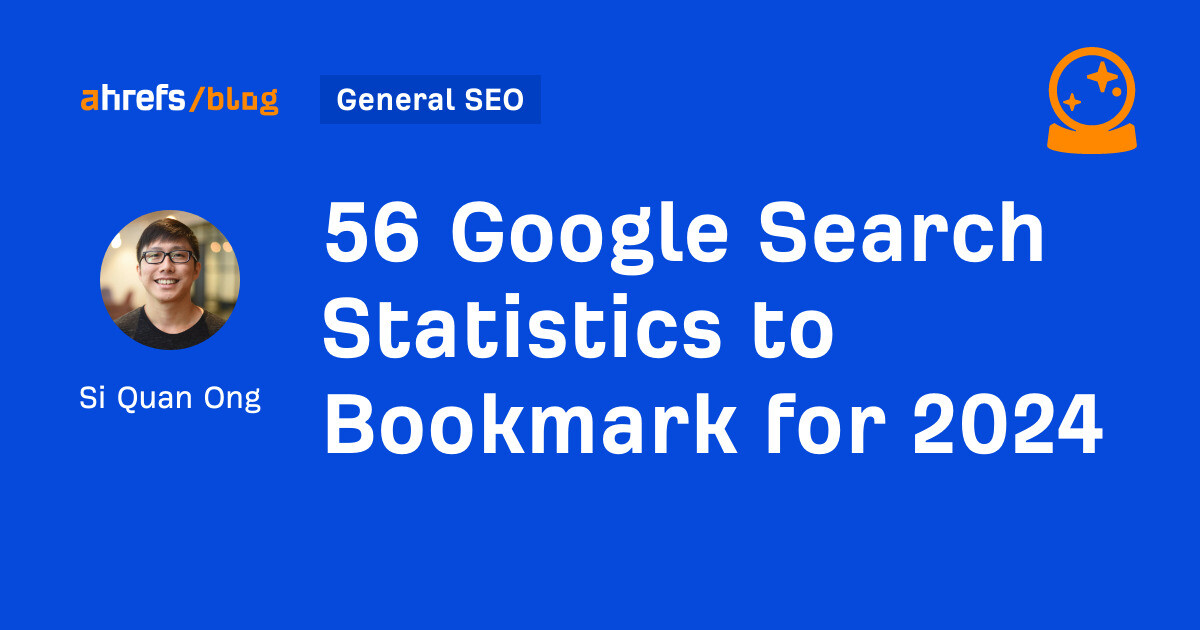
If you’re curious about the state of Google search in 2024, look no further.
Each year we pick, vet, and categorize a list of up-to-date statistics to give you insights from trusted sources on Google search trends.
Check out more resources on how Google works:
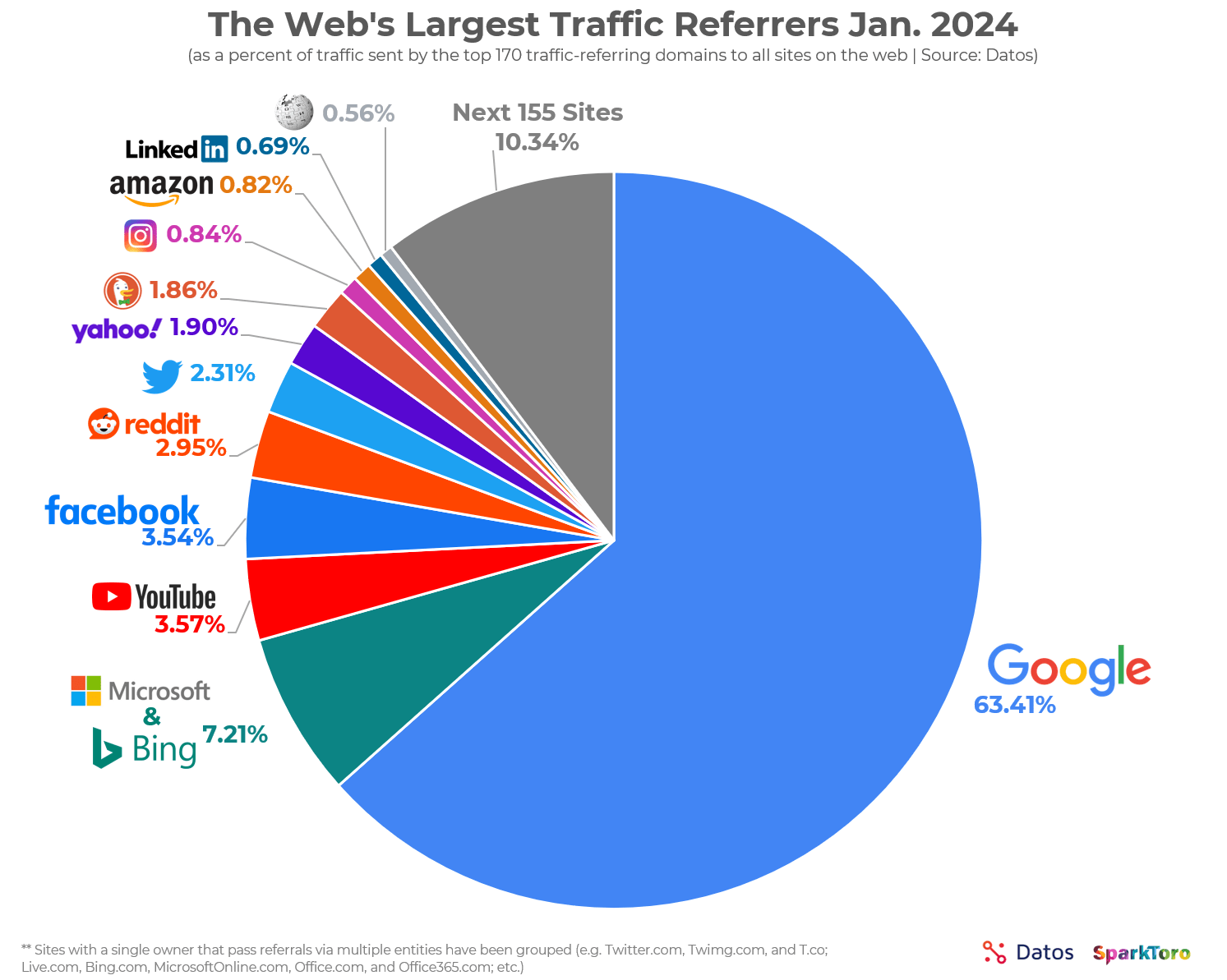

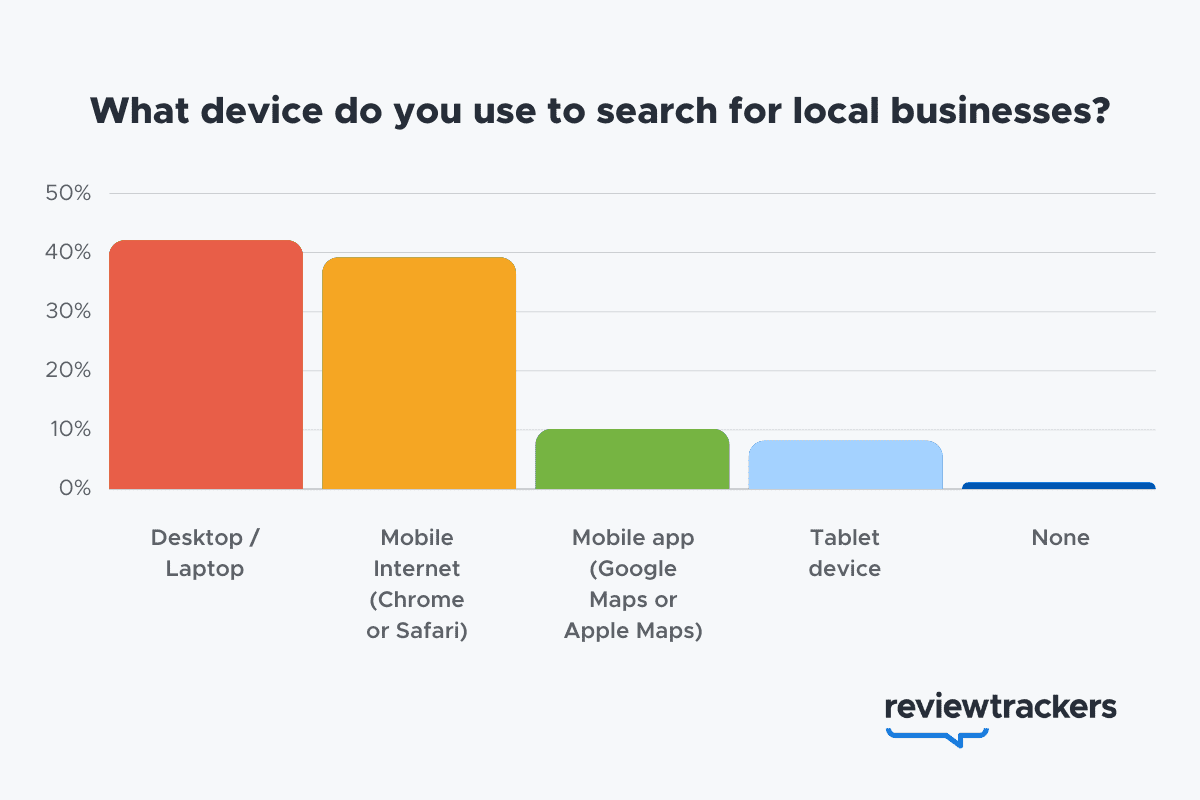

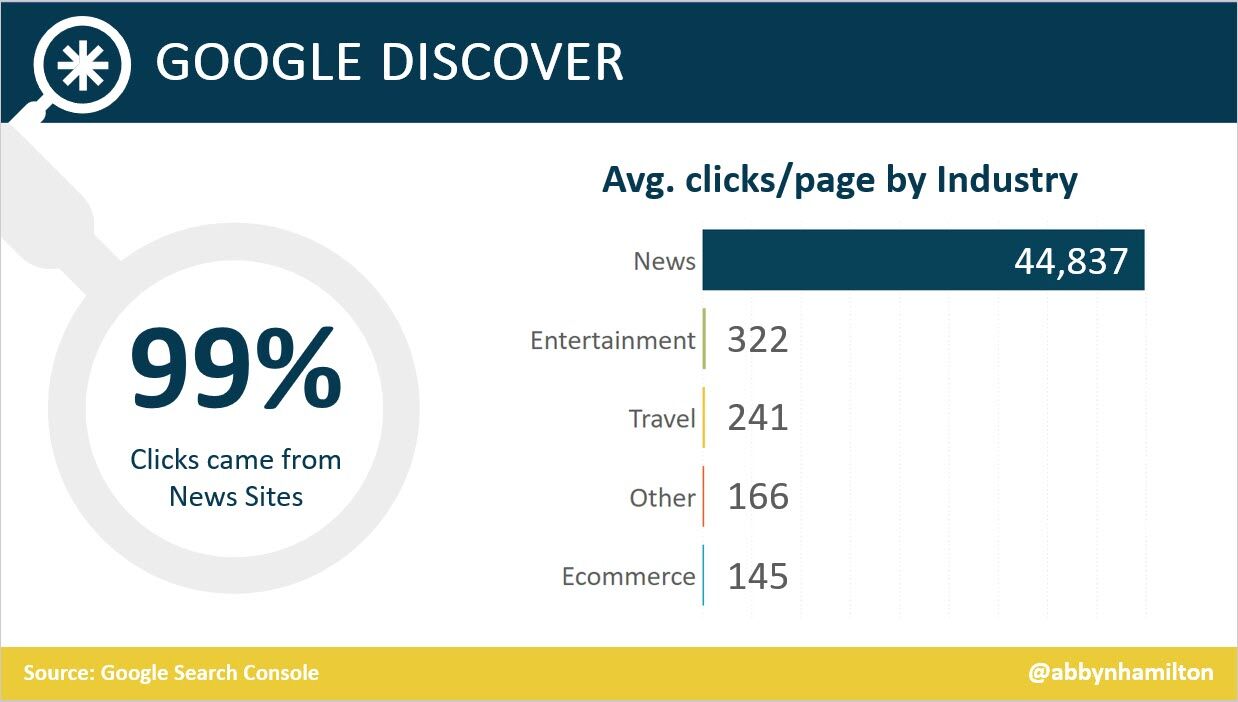

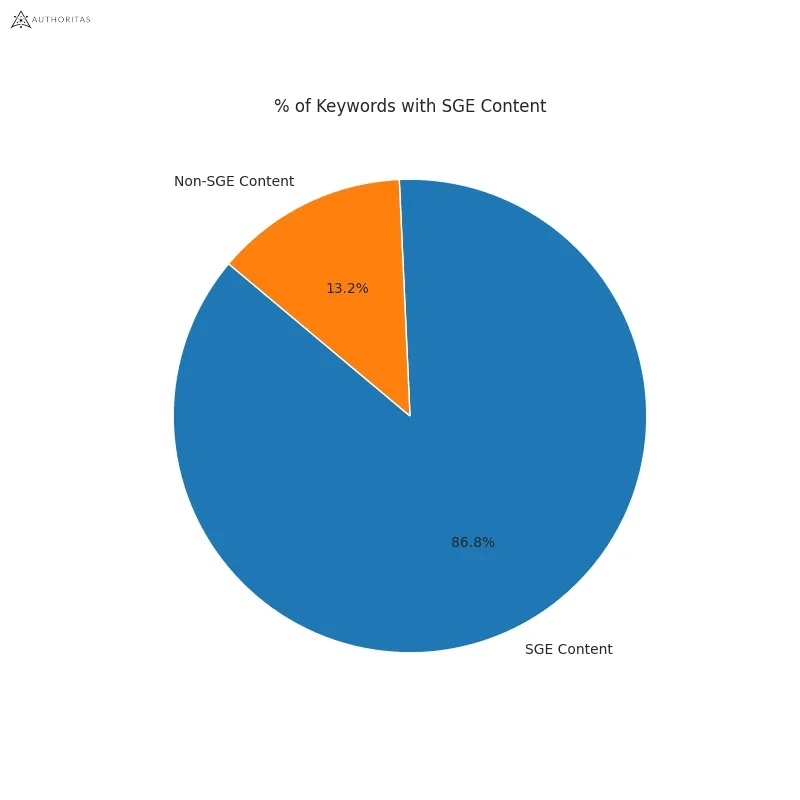

Learn more
SEO
How To Use ChatGPT For Keyword Research

Anyone not using ChatGPT for keyword research is missing a trick.
You can save time and understand an entire topic in seconds instead of hours.
In this article, I outline my most effective ChatGPT prompts for keyword research and teach you how I put them together so that you, too, can take, edit, and enhance them even further.
But before we jump into the prompts, I want to emphasize that you shouldn’t replace keyword research tools or disregard traditional keyword research methods.
ChatGPT can make mistakes. It can even create new keywords if you give it the right prompt. For example, I asked it to provide me with a unique keyword for the topic “SEO” that had never been searched before.
“Interstellar Internet SEO: Optimizing content for the theoretical concept of an interstellar internet, considering the challenges of space-time and interplanetary communication delays.”
Although I want to jump into my LinkedIn profile and update my title to “Interstellar Internet SEO Consultant,” unfortunately, no one has searched that (and they probably never will)!
You must not blindly rely on the data you get back from ChatGPT.
What you can rely on ChatGPT for is the topic ideation stage of keyword research and inspiration.
ChatGPT is a large language model trained with massive amounts of data to accurately predict what word will come next in a sentence. However, it does not know how to do keyword research yet.
Instead, think of ChatGPT as having an expert on any topic armed with the information if you ask it the right question.
In this guide, that is exactly what I aim to teach you how to do – the most essential prompts you need to know when performing topical keyword research.
Best ChatGPT Keyword Research Prompts
The following ChatGPT keyword research prompts can be used on any niche, even a topic to which you are brand new.
For this demonstration, let’s use the topic of “SEO” to demonstrate these prompts.
Generating Keyword Ideas Based On A Topic
What Are The {X} Most Popular Sub-topics Related To {Topic}?
The first prompt is to give you an idea of the niche.
As shown above, ChatGPT did a great job understanding and breaking down SEO into three pillars: on-page, off-page & technical.
The key to the following prompt is to take one of the topics ChatGPT has given and query the sub-topics.
What Are The {X} Most Popular Sub-topics Related To {Sub-topic}?
For this example, let’s query, “What are the most popular sub-topics related to keyword research?”
Having done keyword research for over 10 years, I would expect it to output information related to keyword research metrics, the types of keywords, and intent.
Let’s see.
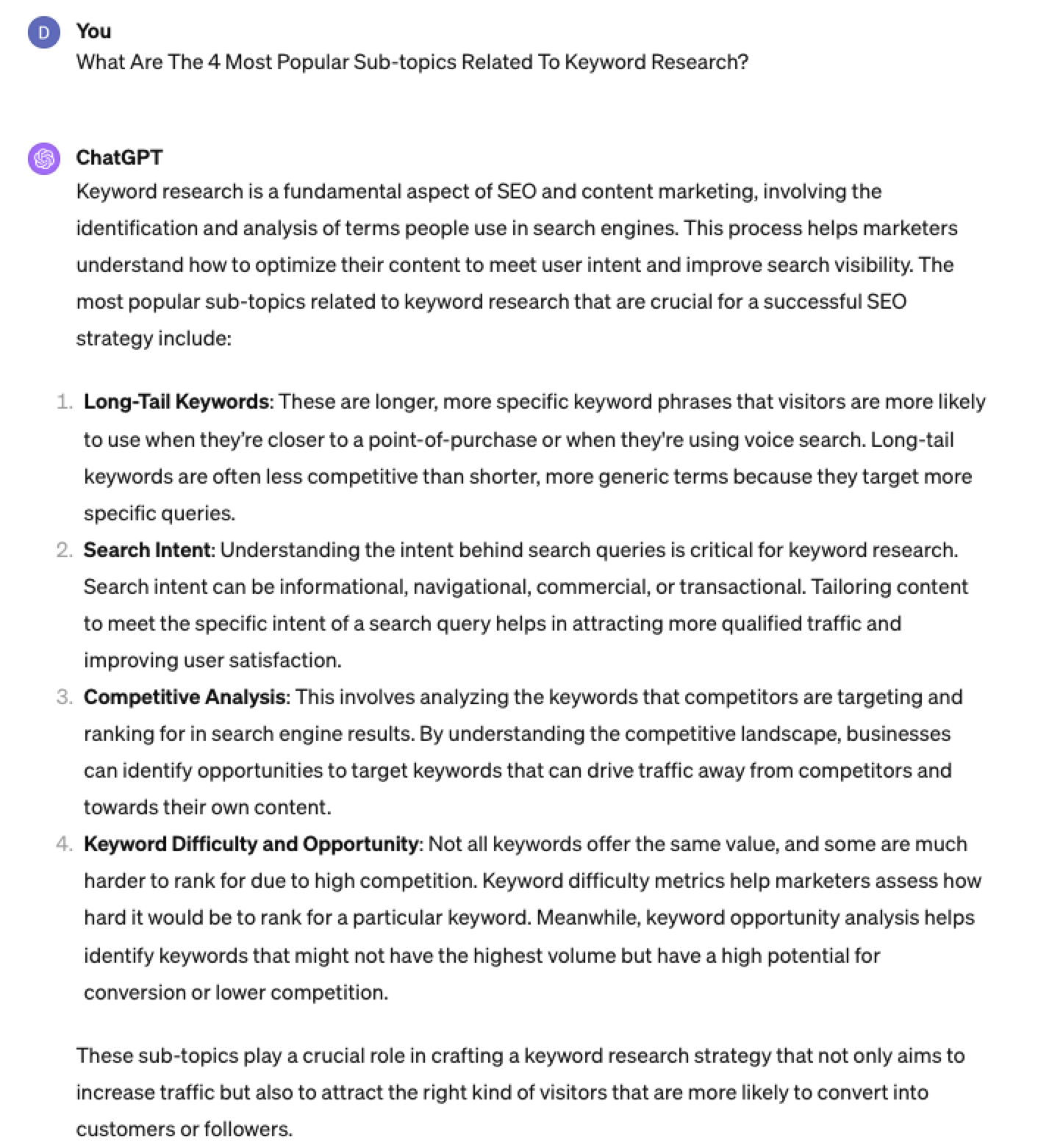 Screenshot from ChatGPT 4, April 2024
Screenshot from ChatGPT 4, April 2024Again, right on the money.
To get the keywords you want without having ChatGPT describe each answer, use the prompt “list without description.”
Here is an example of that.
List Without Description The Top {X} Most Popular Keywords For The Topic Of {X}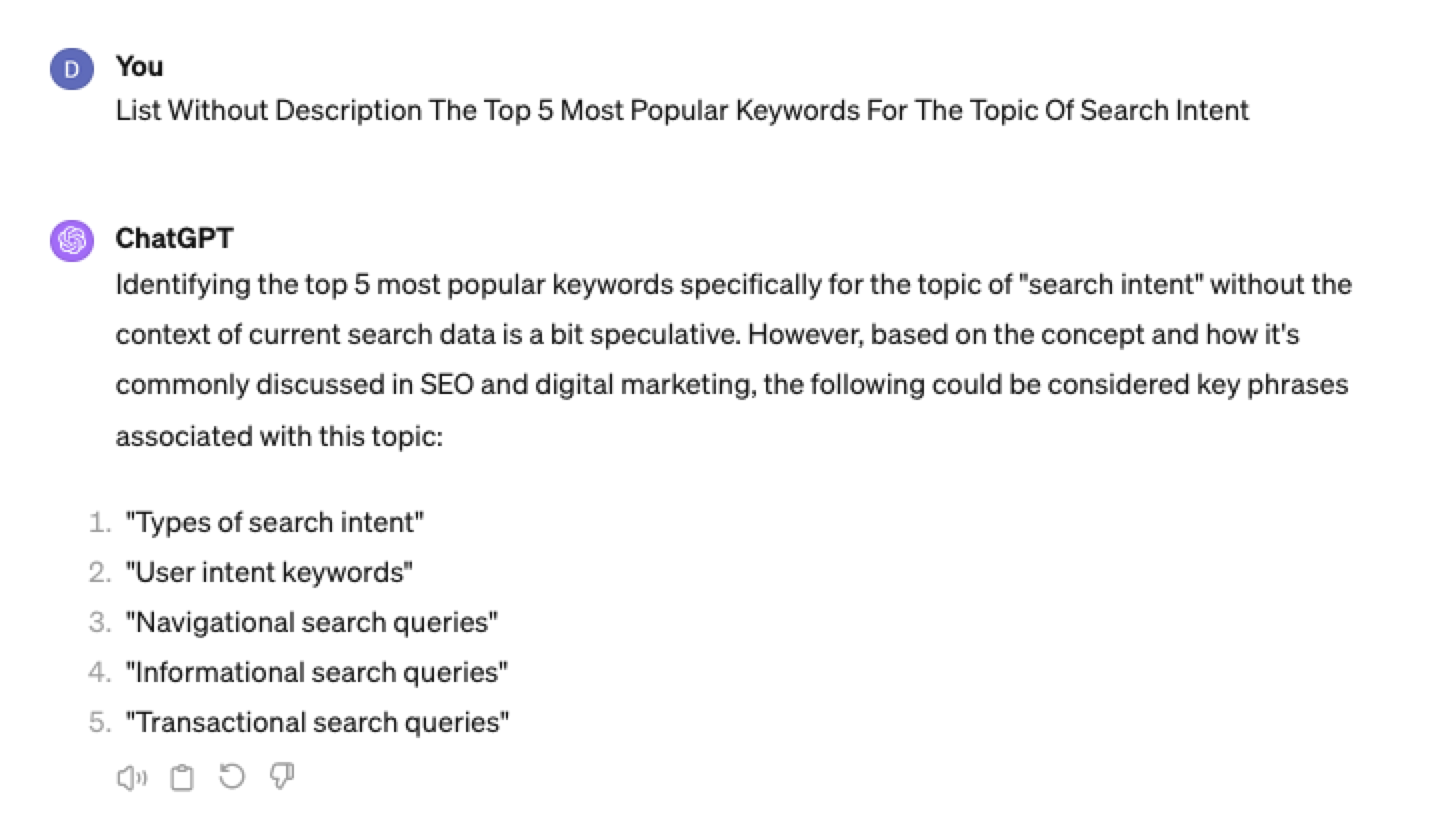
You can even branch these keywords out further into their long-tail.
Example prompt:
List Without Description The Top {X} Most Popular Long-tail Keywords For The Topic “{X}”
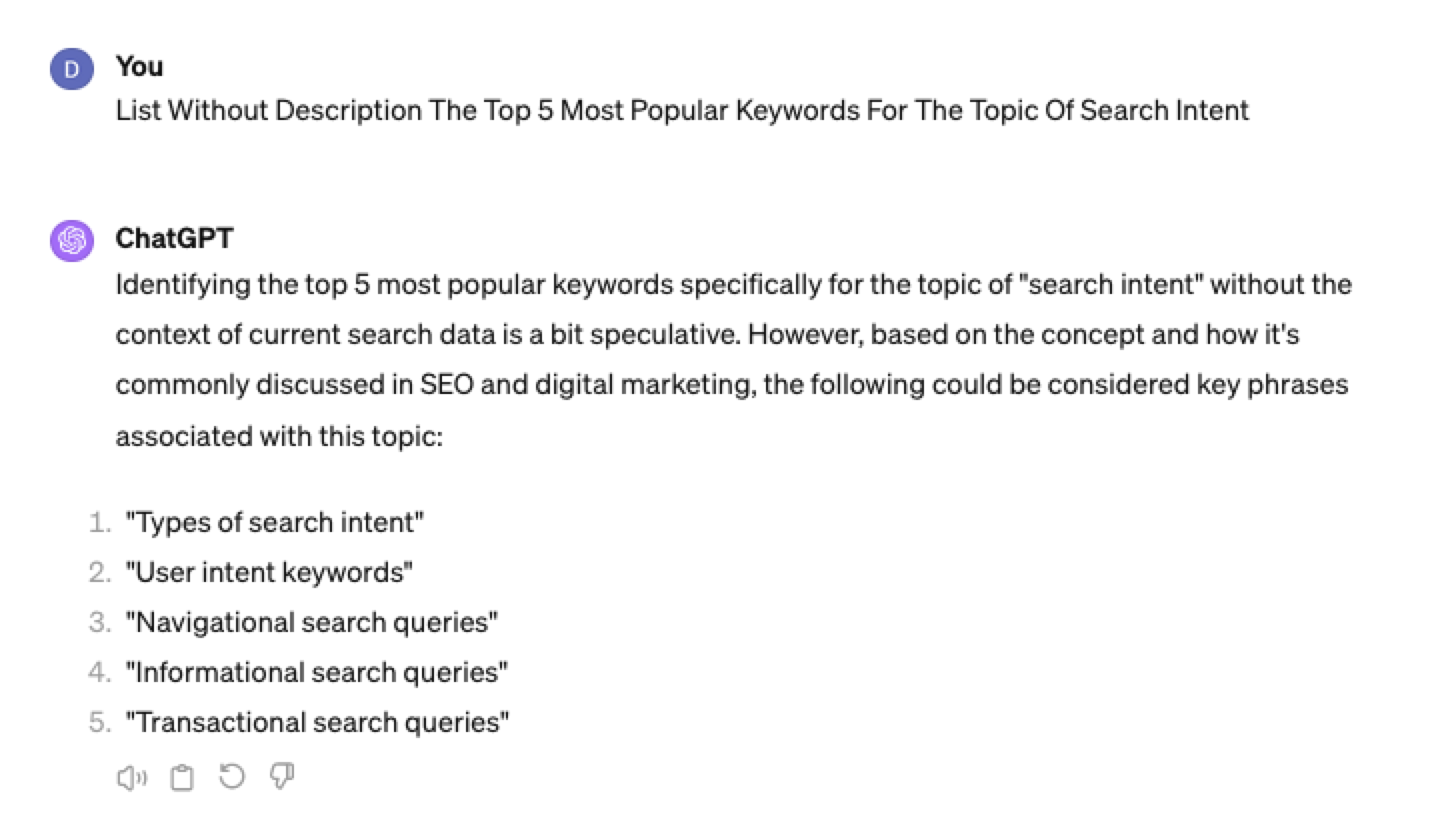 Screenshot ChatGPT 4,April 2024
Screenshot ChatGPT 4,April 2024List Without Description The Top Semantically Related Keywords And Entities For The Topic {X}
You can even ask ChatGPT what any topic’s semantically related keywords and entities are!
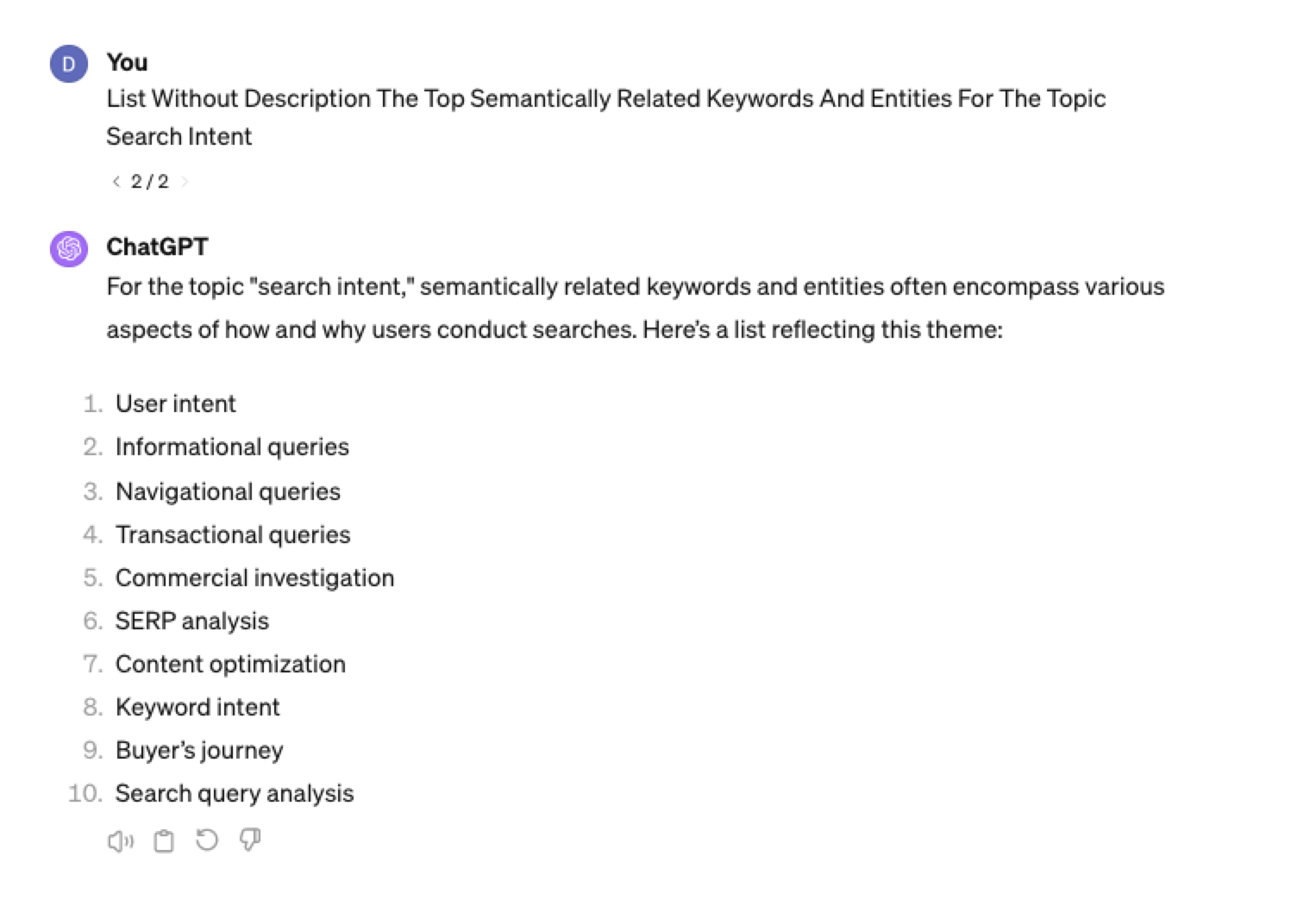 Screenshot ChatGPT 4, April 2024
Screenshot ChatGPT 4, April 2024Tip: The Onion Method Of Prompting ChatGPT
When you are happy with a series of prompts, add them all to one prompt. For example, so far in this article, we have asked ChatGPT the following:
- What are the four most popular sub-topics related to SEO?
- What are the four most popular sub-topics related to keyword research
- List without description the top five most popular keywords for “keyword intent”?
- List without description the top five most popular long-tail keywords for the topic “keyword intent types”?
- List without description the top semantically related keywords and entities for the topic “types of keyword intent in SEO.”
Combine all five into one prompt by telling ChatGPT to perform a series of steps. Example:
“Perform the following steps in a consecutive order Step 1, Step 2, Step 3, Step 4, and Step 5”
Example:
“Perform the following steps in a consecutive order Step 1, Step 2, Step 3, Step 4 and Step 5. Step 1 – Generate an answer for the 3 most popular sub-topics related to {Topic}?. Step 2 – Generate 3 of the most popular sub-topics related to each answer. Step 3 – Take those answers and list without description their top 3 most popular keywords. Step 4 – For the answers given of their most popular keywords, provide 3 long-tail keywords. Step 5 – for each long-tail keyword offered in the response, a list without descriptions 3 of their top semantically related keywords and entities.”
Generating Keyword Ideas Based On A Question
Taking the steps approach from above, we can get ChatGPT to help streamline getting keyword ideas based on a question. For example, let’s ask, “What is SEO?”
“Perform the following steps in a consecutive order Step 1, Step 2, Step 3, and Step 4. Step 1 Generate 10 questions about “{Question}”?. Step 2 – Generate 5 more questions about “{Question}” that do not repeat the above. Step 3 – Generate 5 more questions about “{Question}” that do not repeat the above. Step 4 – Based on the above Steps 1,2,3 suggest a final list of questions avoiding duplicates or semantically similar questions.”
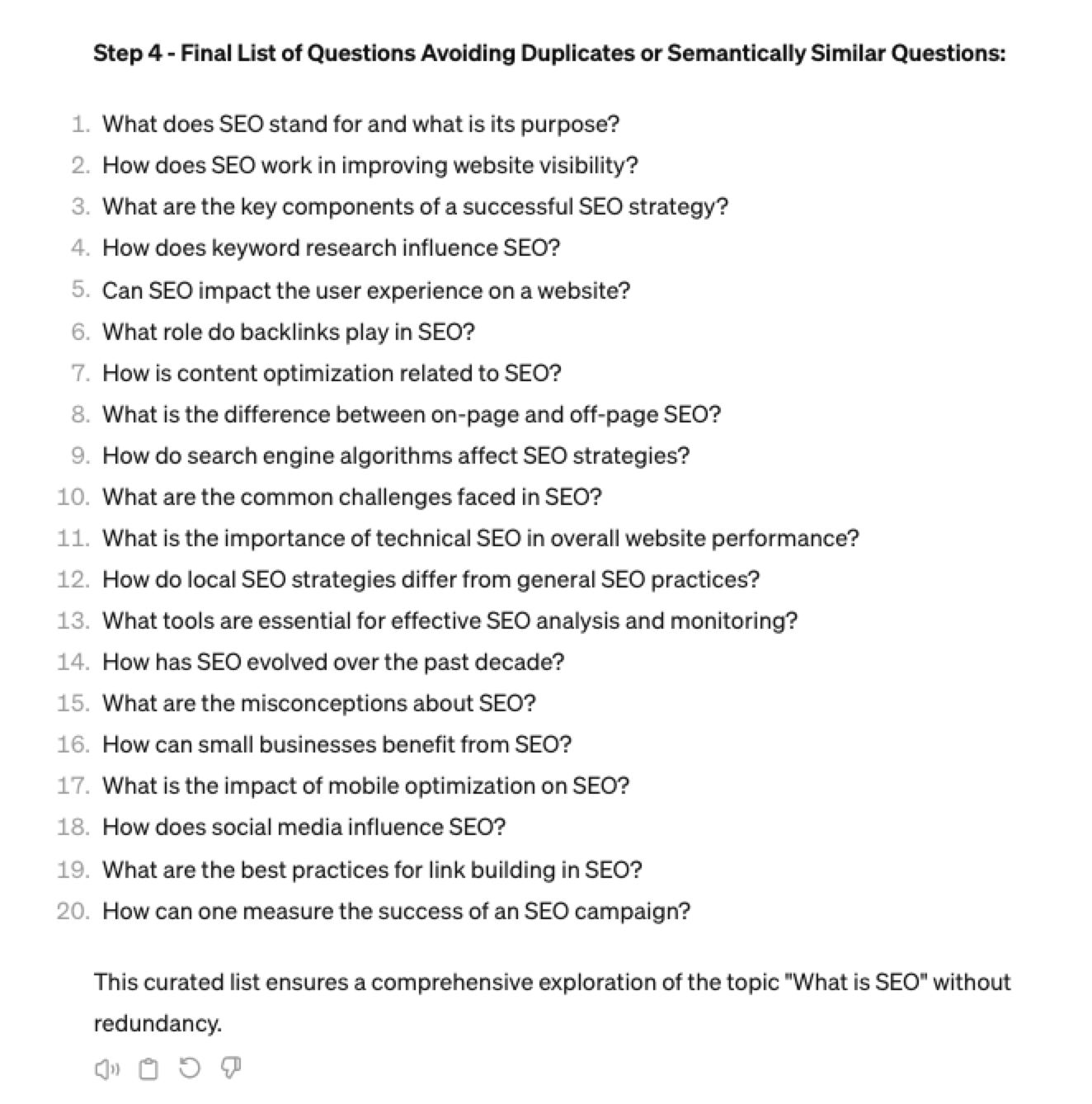 Screenshot ChatGPT 4, April 2024
Screenshot ChatGPT 4, April 2024Generating Keyword Ideas Using ChatGPT Based On The Alphabet Soup Method
One of my favorite methods, manually, without even using a keyword research tool, is to generate keyword research ideas from Google autocomplete, going from A to Z.
-
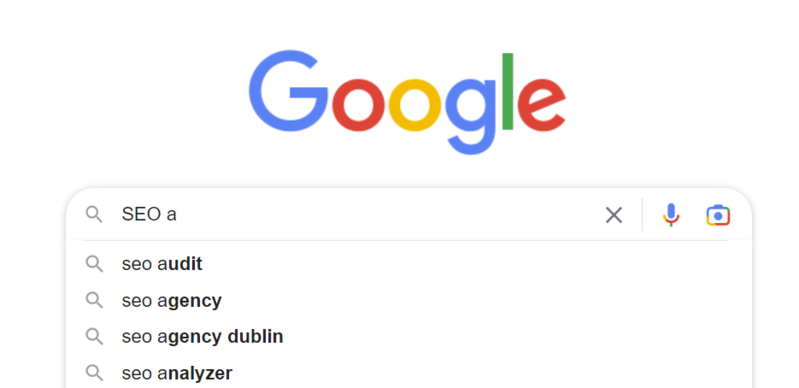 Screenshot from Google autocomplete, April 2024
Screenshot from Google autocomplete, April 2024
You can also do this using ChatGPT.
Example prompt:
“give me popular keywords that includes the keyword “SEO”, and the next letter of the word starts with a”
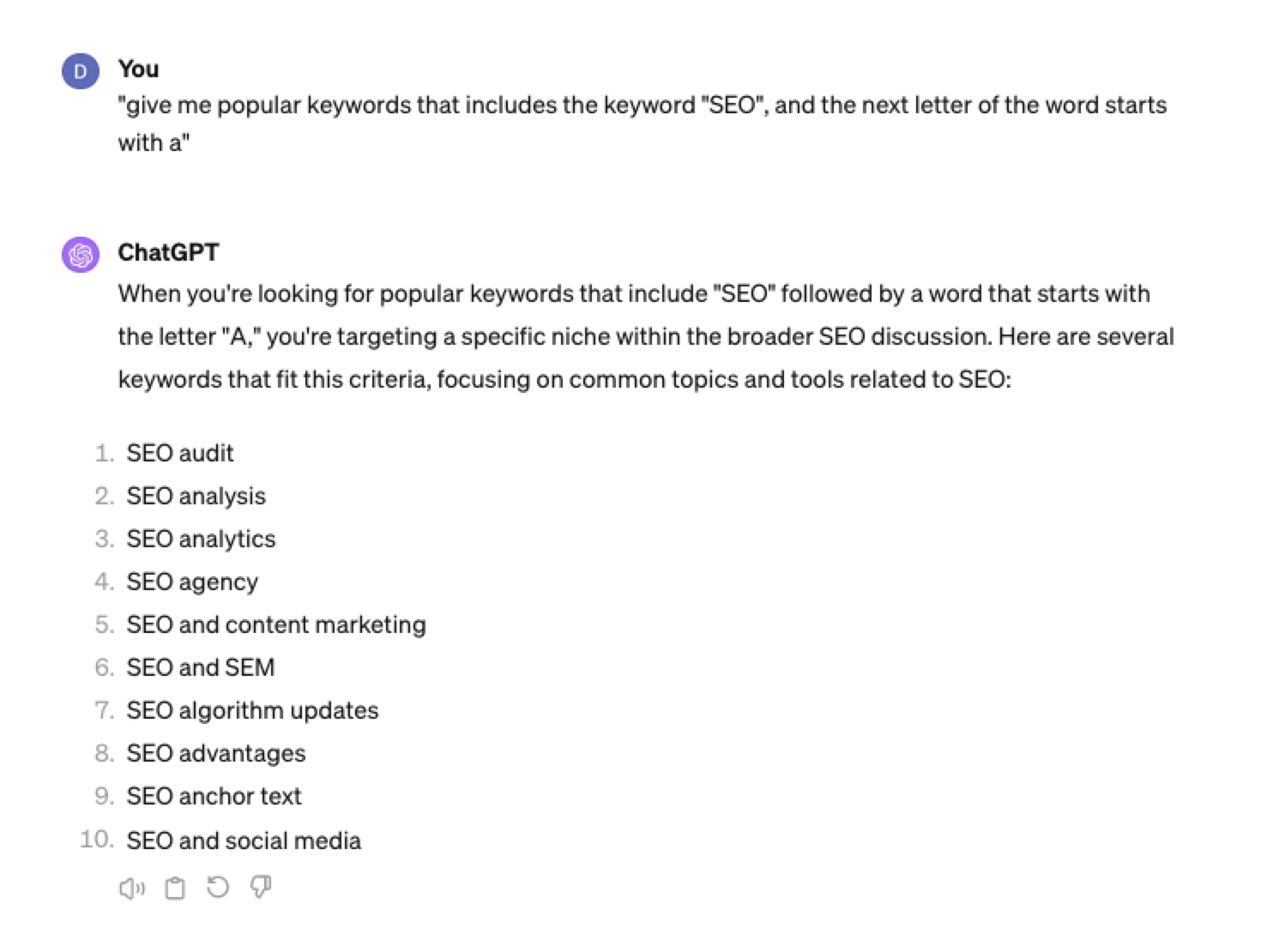 Screenshot from ChatGPT 4, April 2024
Screenshot from ChatGPT 4, April 2024Tip: Using the onion prompting method above, we can combine all this in one prompt.
“Give me five popular keywords that include “SEO” in the word, and the following letter starts with a. Once the answer has been done, move on to giving five more popular keywords that include “SEO” for each letter of the alphabet b to z.”
Generating Keyword Ideas Based On User Personas
When it comes to keyword research, understanding user personas is essential for understanding your target audience and keeping your keyword research focused and targeted. ChatGPT may help you get an initial understanding of customer personas.
Example prompt:
“For the topic of “{Topic}” list 10 keywords each for the different types of user personas”
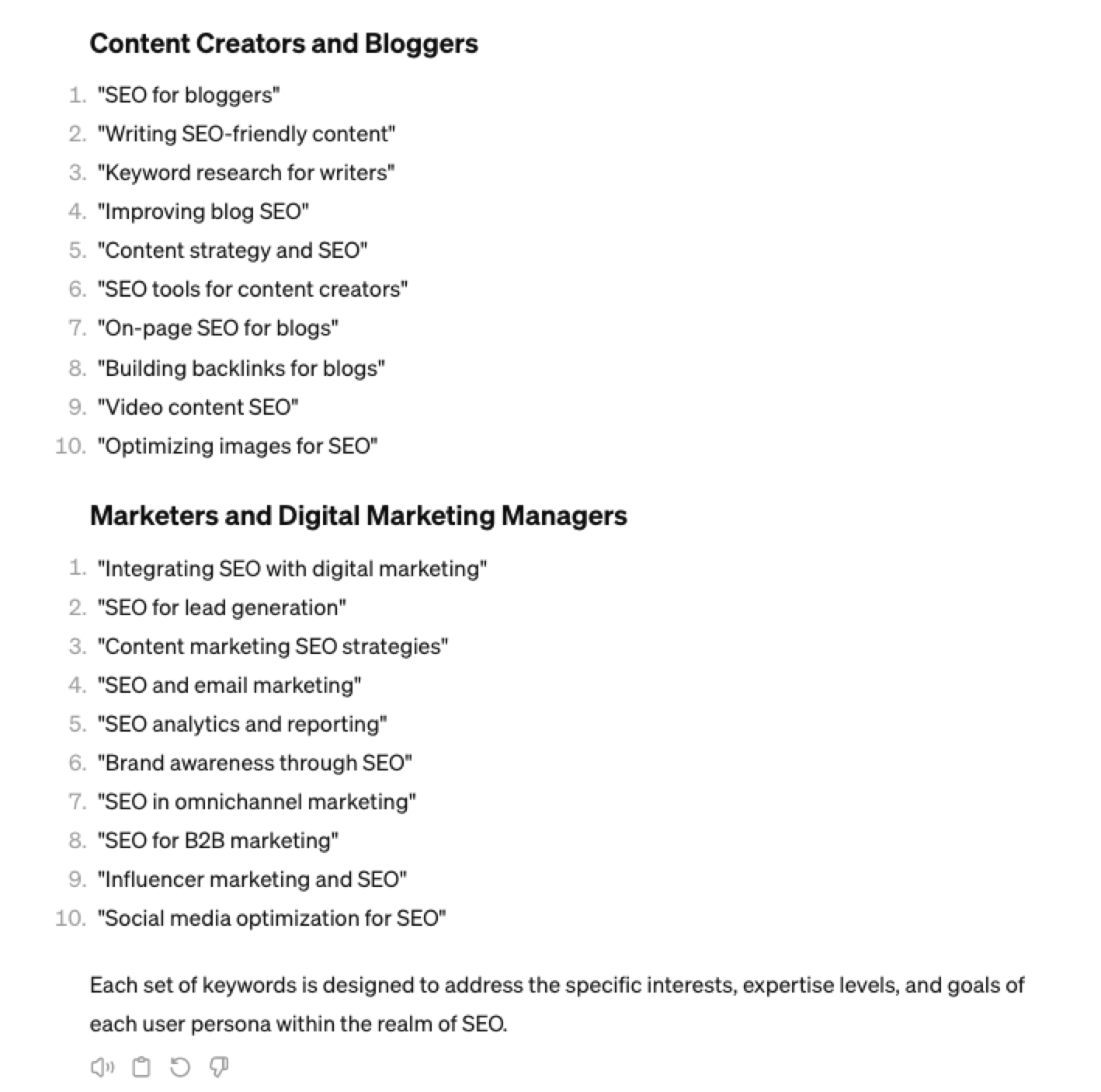 Screenshot from ChatGPT 4, April 2024
Screenshot from ChatGPT 4, April 2024You could even go a step further and ask for questions based on those topics that those specific user personas may be searching for:
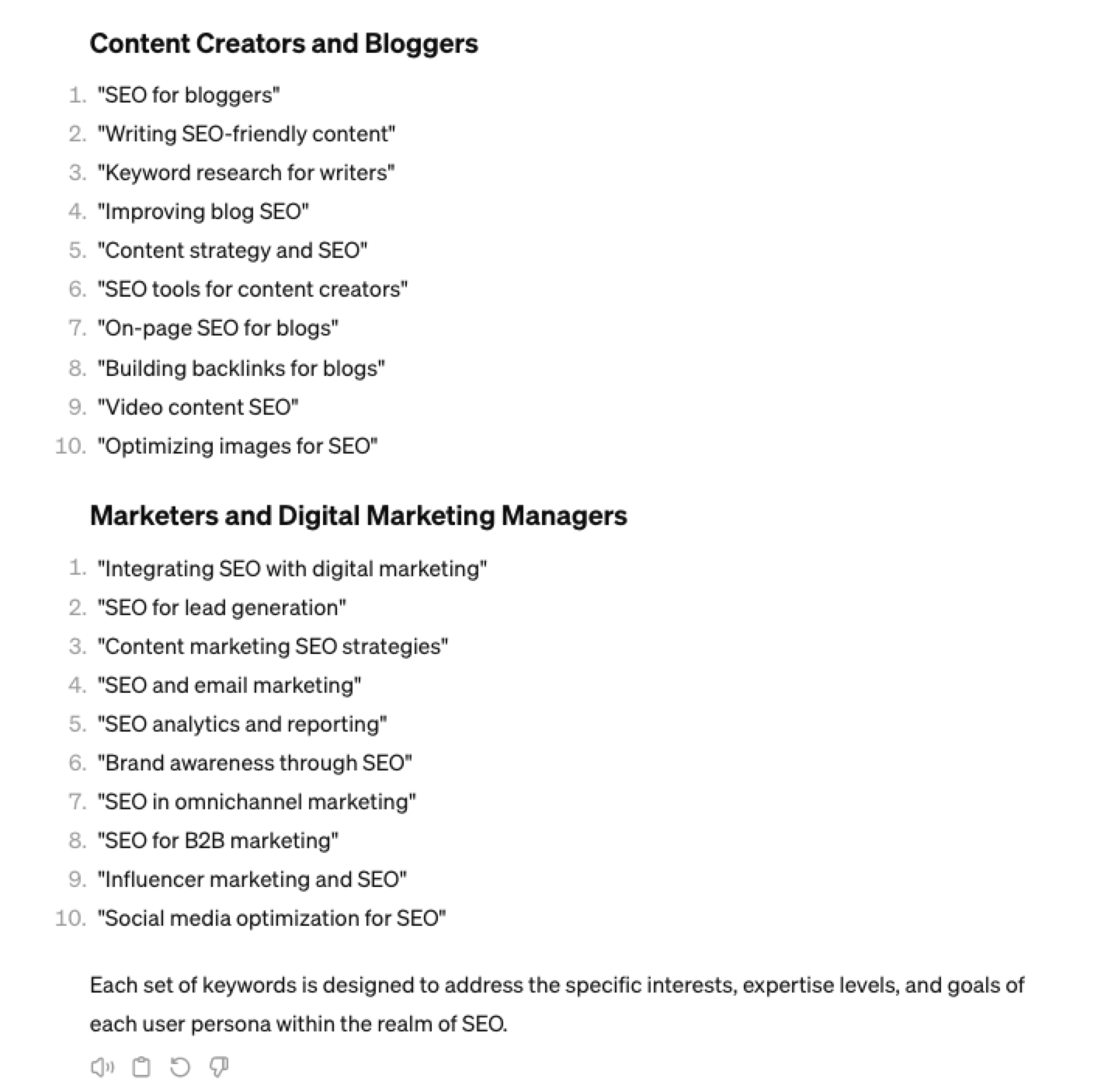 Screenshot ChatGPT 4, April 2024
Screenshot ChatGPT 4, April 2024As well as get the keywords to target based on those questions:
“For each question listed above for each persona, list the keywords, as well as the long-tail keywords to target, and put them in a table”
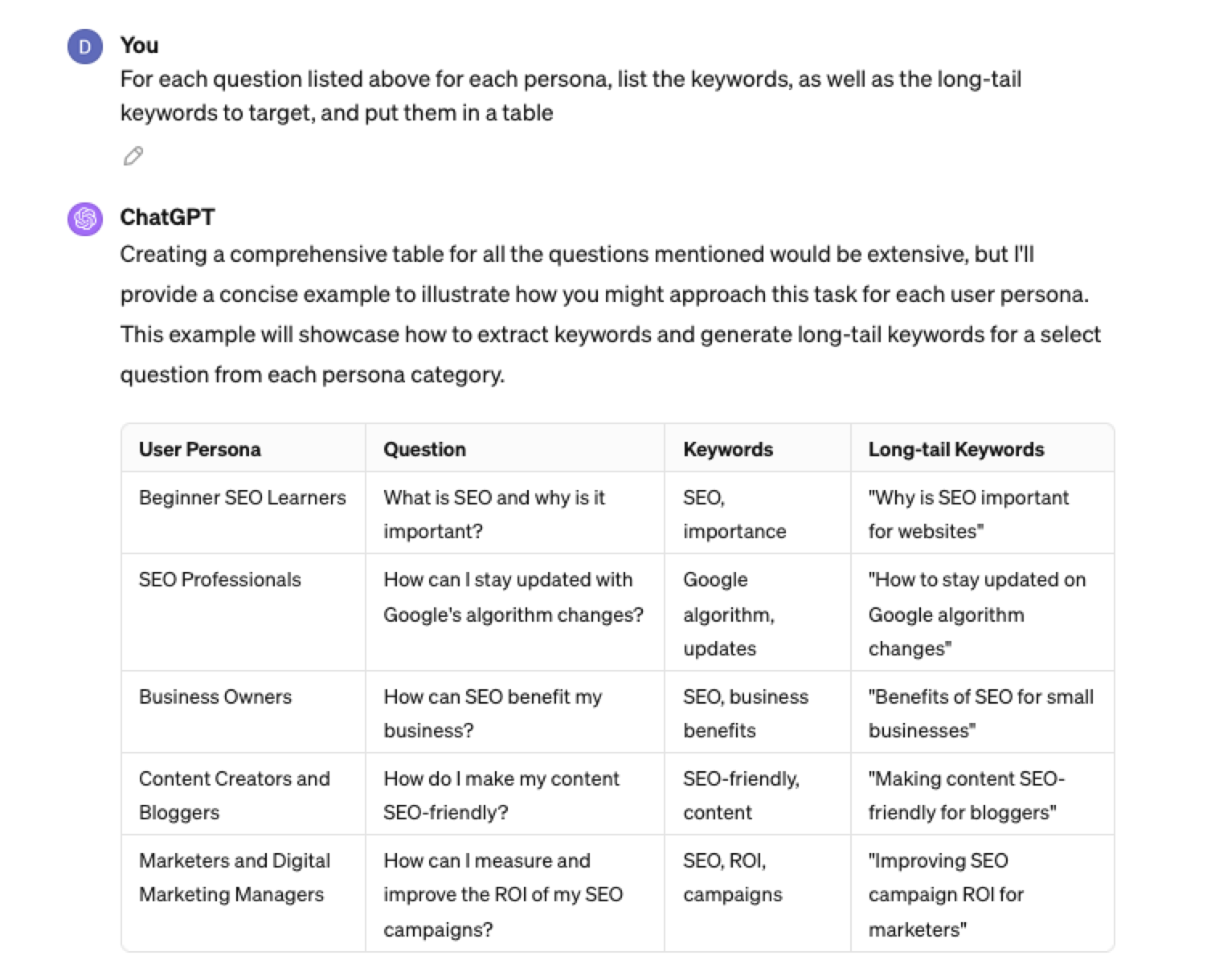 Screenshot from ChatGPT 4, April 2024
Screenshot from ChatGPT 4, April 2024Generating Keyword Ideas Using ChatGPT Based On Searcher Intent And User Personas
Understanding the keywords your target persona may be searching is the first step to effective keyword research. The next step is to understand the search intent behind those keywords and which content format may work best.
For example, a business owner who is new to SEO or has just heard about it may be searching for “what is SEO.”
However, if they are further down the funnel and in the navigational stage, they may search for “top SEO firms.”
You can query ChatGPT to inspire you here based on any topic and your target user persona.
SEO Example:
“For the topic of “{Topic}” list 10 keywords each for the different types of searcher intent that a {Target Persona} would be searching for”
ChatGPT For Keyword Research Admin
Here is how you can best use ChatGPT for keyword research admin tasks.
Using ChatGPT As A Keyword Categorization Tool
One of the use cases for using ChatGPT is for keyword categorization.
In the past, I would have had to devise spreadsheet formulas to categorize keywords or even spend hours filtering and manually categorizing keywords.
ChatGPT can be a great companion for running a short version of this for you.
Let’s say you have done keyword research in a keyword research tool, have a list of keywords, and want to categorize them.
You could use the following prompt:
“Filter the below list of keywords into categories, target persona, searcher intent, search volume and add information to a six-column table: List of keywords – [LIST OF KEYWORDS], Keyword Search Volume [SEARCH VOLUMES] and Keyword Difficulties [KEYWORD DIFFICUTIES].”
-
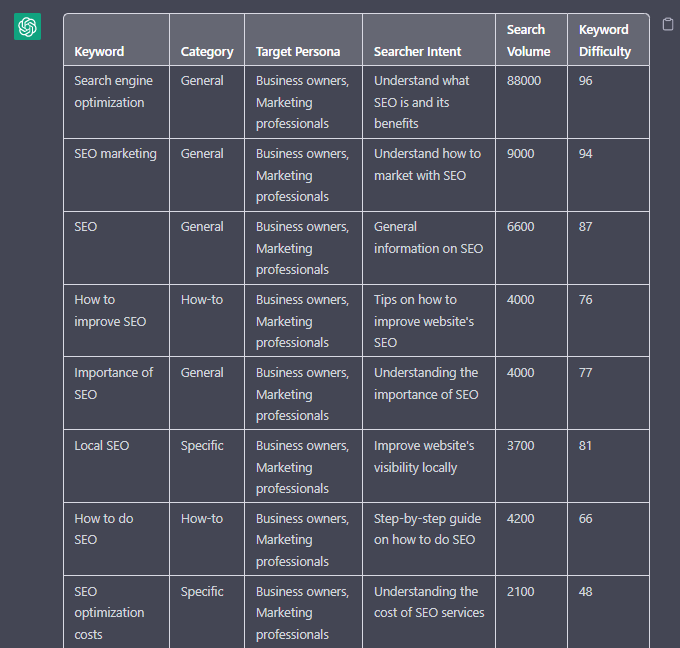 Screenshot from ChatGPT, April 2024
Screenshot from ChatGPT, April 2024
Tip: Add keyword metrics from the keyword research tools, as using the search volumes that a ChatGPT prompt may give you will be wildly inaccurate at best.
Using ChatGPT For Keyword Clustering
Another of ChatGPT’s use cases for keyword research is to help you cluster. Many keywords have the same intent, and by grouping related keywords, you may find that one piece of content can often target multiple keywords at once.
However, be careful not to rely only on LLM data for clustering. What ChatGPT may cluster as a similar keyword, the SERP or the user may not agree with. But it is a good starting point.
The big downside of using ChatGPT for keyword clustering is actually the amount of keyword data you can cluster based on the memory limits.
So, you may find a keyword clustering tool or script that is better for large keyword clustering tasks. But for small amounts of keywords, ChatGPT is actually quite good.
A great use small keyword clustering use case using ChatGPT is for grouping People Also Ask (PAA) questions.
Use the following prompt to group keywords based on their semantic relationships. For example:
“Organize the following keywords into groups based on their semantic relationships, and give a short name to each group: [LIST OF PAA], create a two-column table where each keyword sits on its own row.
-
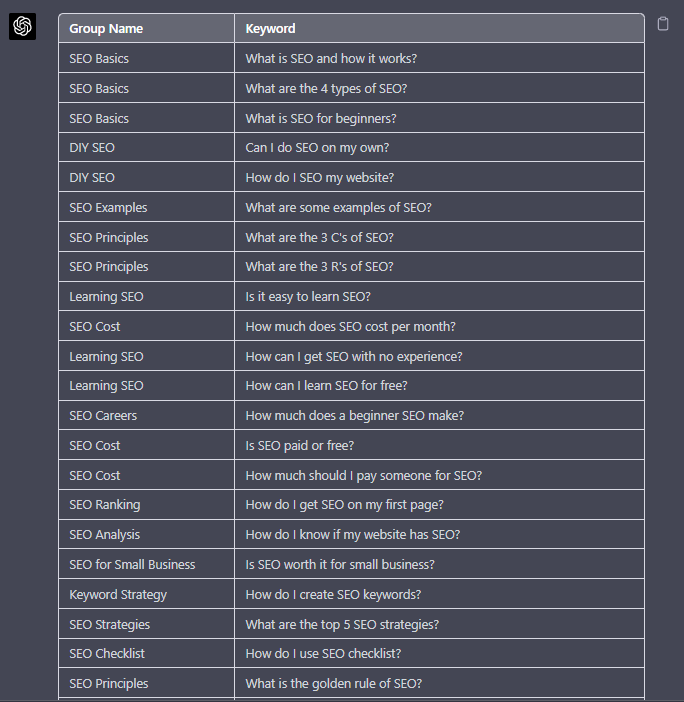 Screenshot from ChatGPT, April 2024
Screenshot from ChatGPT, April 2024
Using Chat GPT For Keyword Expansion By Patterns
One of my favorite methods of doing keyword research is pattern spotting.
Most seed keywords have a variable that can expand your target keywords.
Here are a few examples of patterns:
1. Question Patterns
(who, what, where, why, how, are, can, do, does, will)
“Generate [X] keywords for the topic “[Topic]” that contain any or all of the following “who, what, where, why, how, are, can, do, does, will”
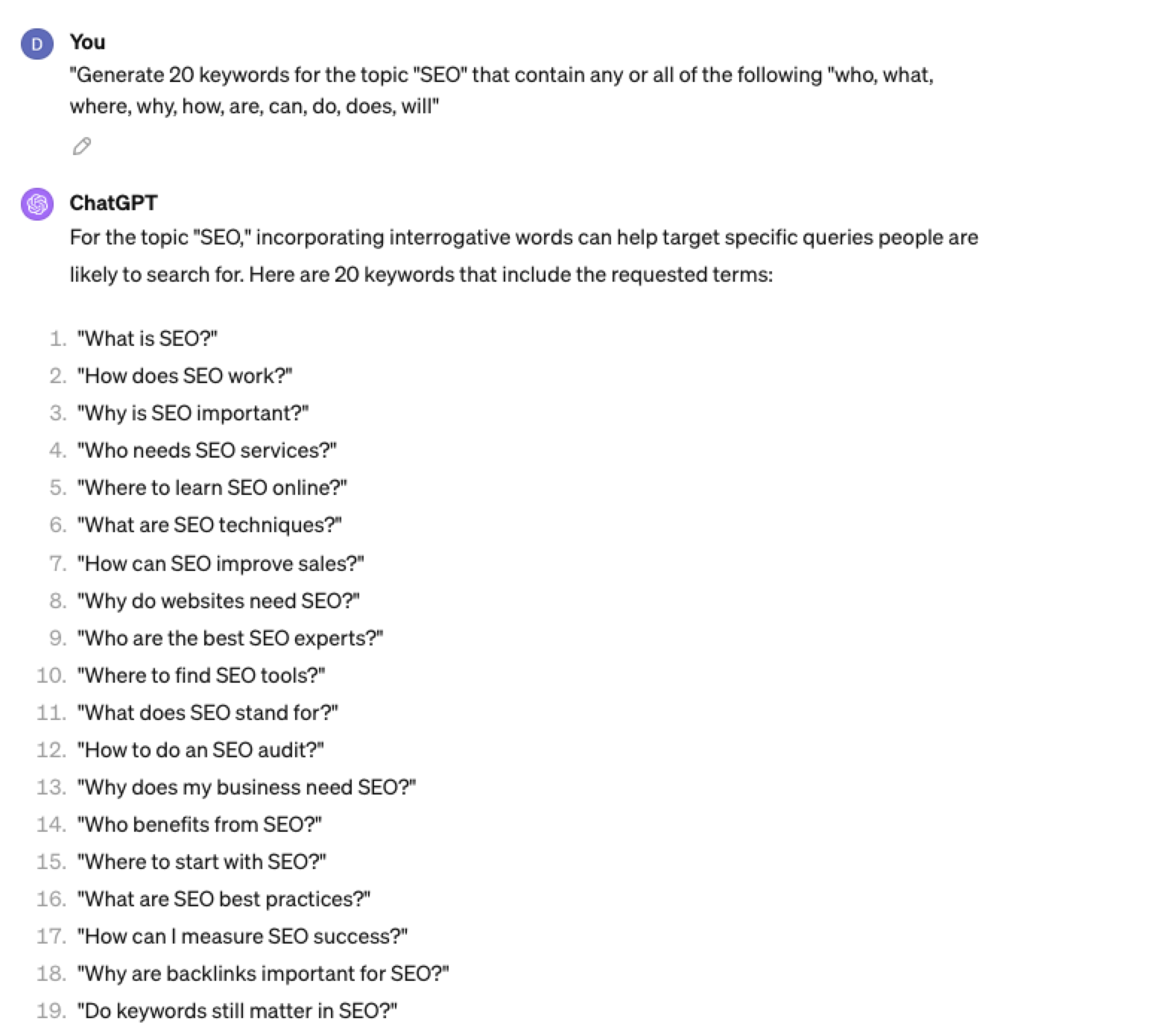 Screenshot ChatGPT 4, April 2024
Screenshot ChatGPT 4, April 20242. Comparison Patterns
Example:
“Generate 50 keywords for the topic “{Topic}” that contain any or all of the following “for, vs, alternative, best, top, review”
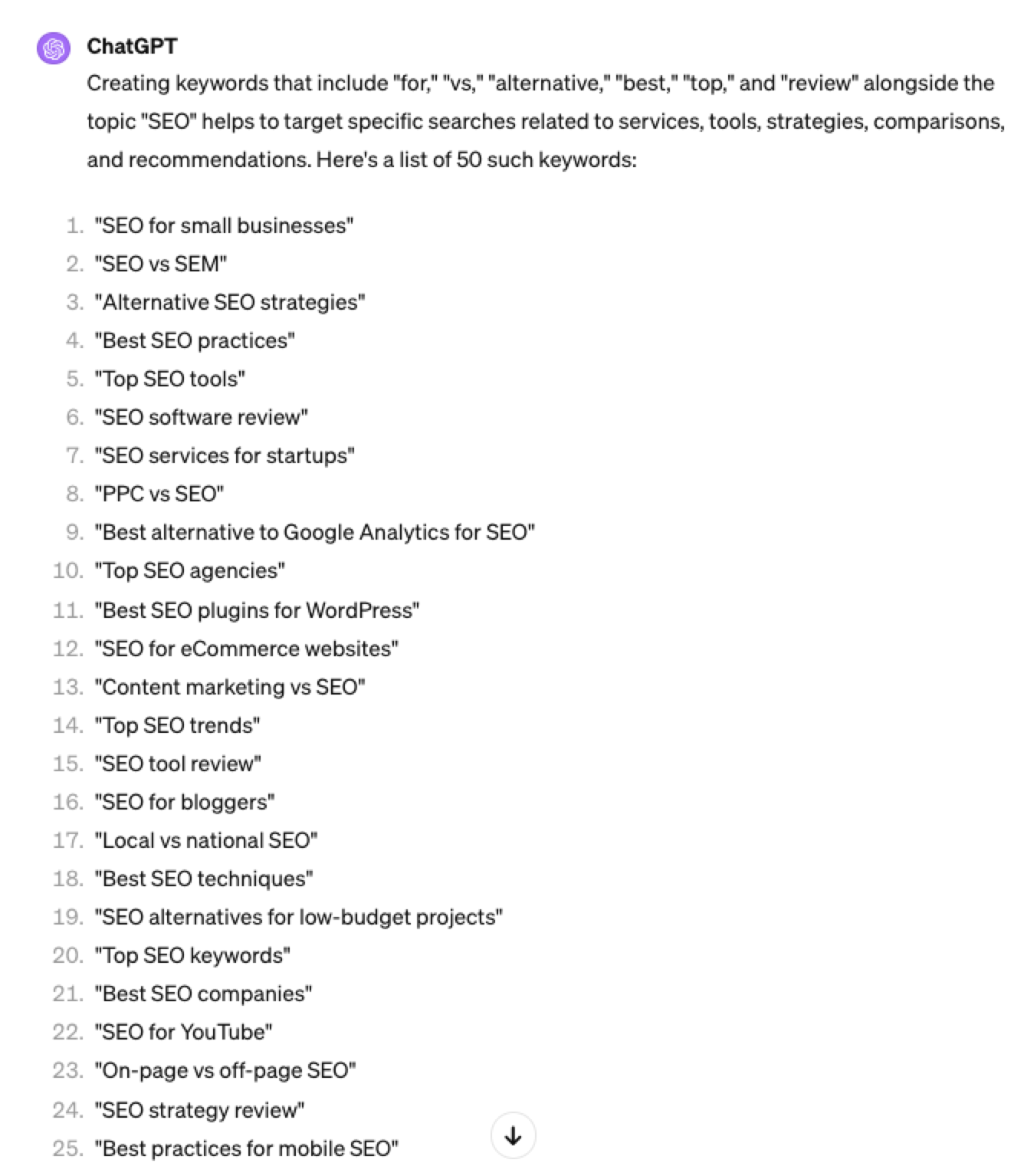 Screenshot ChatGPT 4, April 2024
Screenshot ChatGPT 4, April 20243. Brand Patterns
Another one of my favorite modifiers is a keyword by brand.
We are probably all familiar with the most popular SEO brands; however, if you aren’t, you could ask your AI friend to do the heavy lifting.
Example prompt:
“For the top {Topic} brands what are the top “vs” keywords”
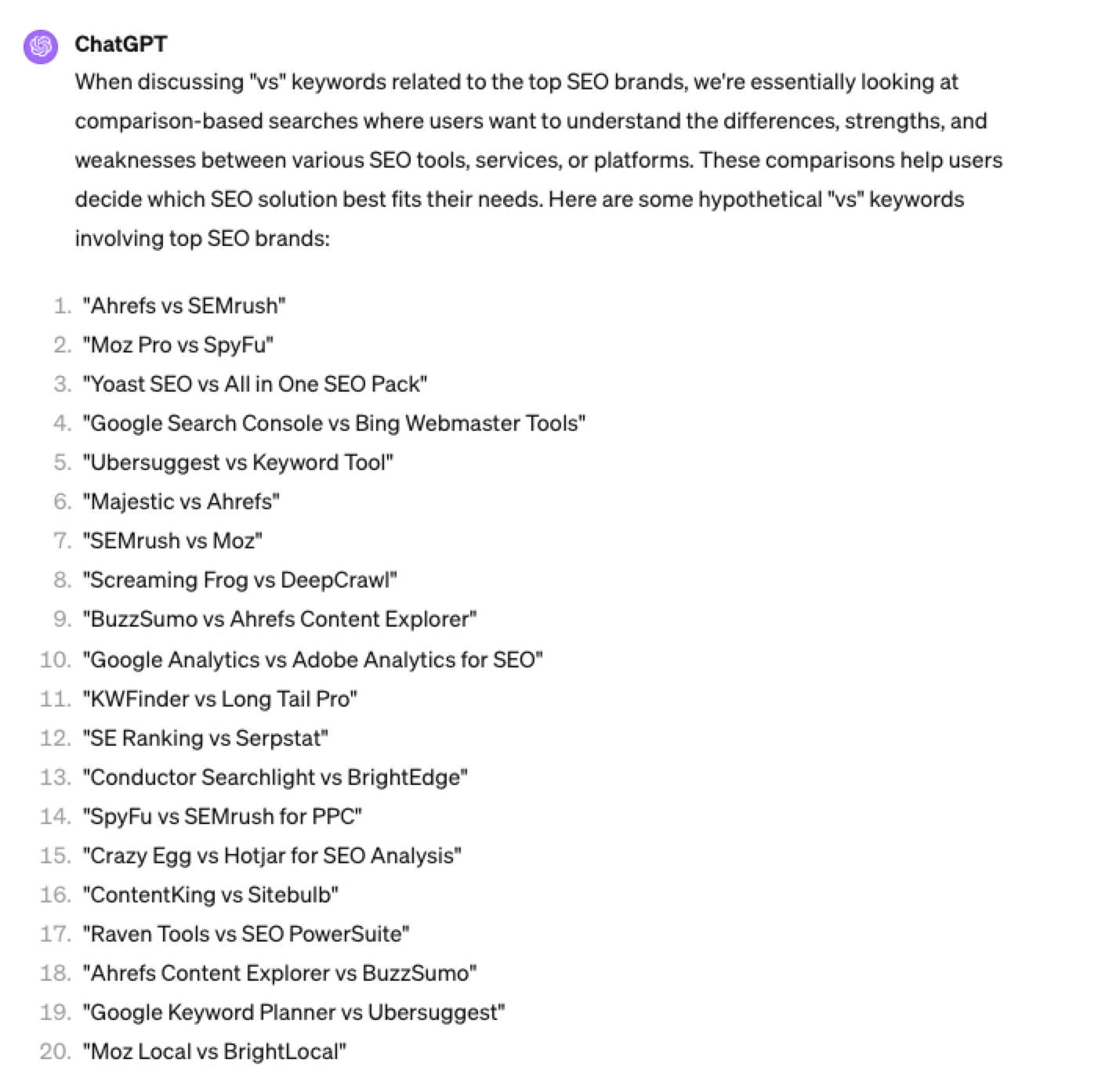 Screenshot ChatGPT 4, April 2024
Screenshot ChatGPT 4, April 20244. Search Intent Patterns
One of the most common search intent patterns is “best.”
When someone is searching for a “best {topic}” keyword, they are generally searching for a comprehensive list or guide that highlights the top options, products, or services within that specific topic, along with their features, benefits, and potential drawbacks, to make an informed decision.
Example:
“For the topic of “[Topic]” what are the 20 top keywords that include “best”
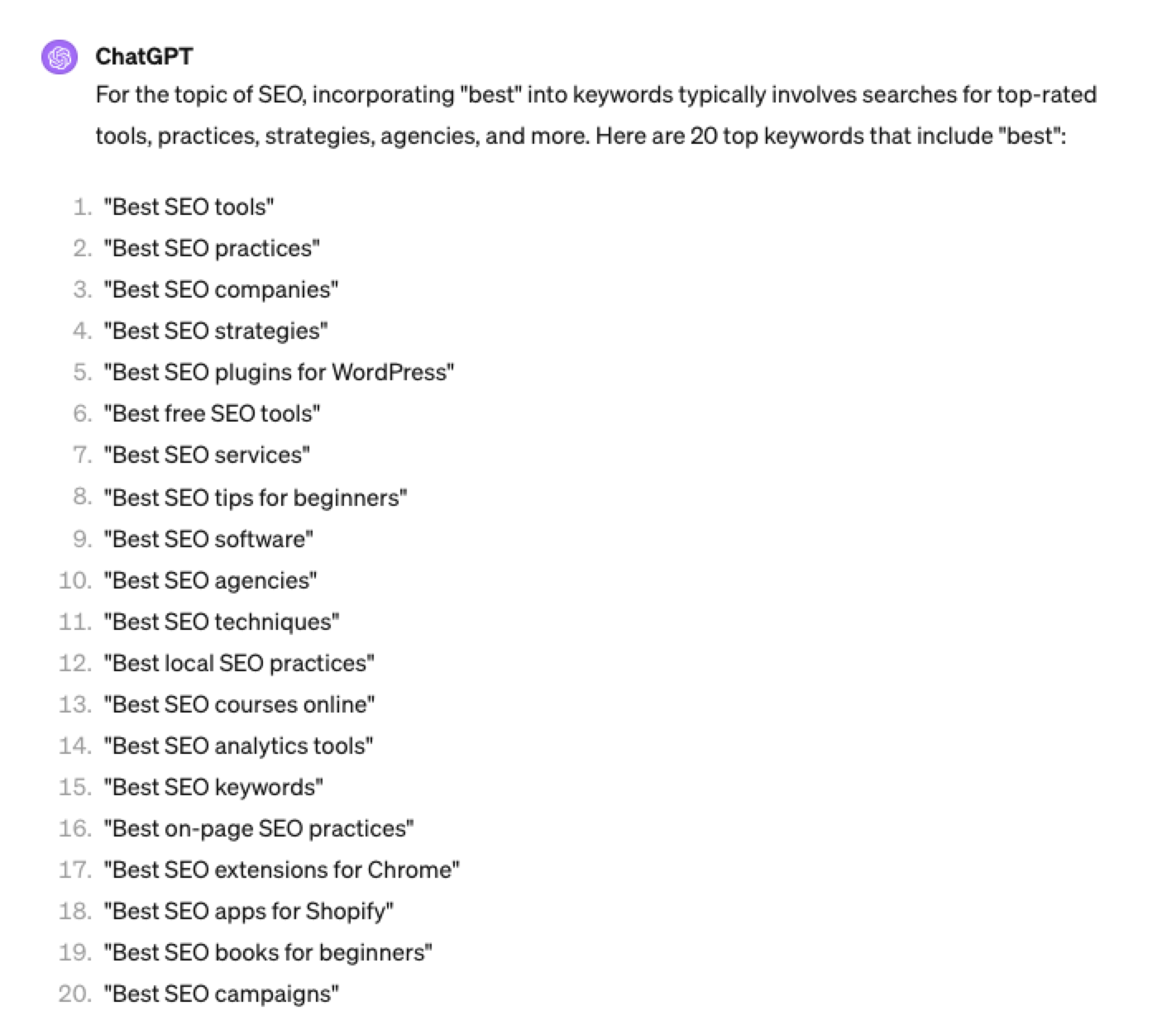 Screenshot ChatGPT 4, April 2024
Screenshot ChatGPT 4, April 2024Again, this guide to keyword research using ChatGPT has emphasized the ease of generating keyword research ideas by utilizing ChatGPT throughout the process.
Keyword Research Using ChatGPT Vs. Keyword Research Tools
Free Vs. Paid Keyword Research Tools
Like keyword research tools, ChatGPT has free and paid options.
However, one of the most significant drawbacks of using ChatGPT for keyword research alone is the absence of SEO metrics to help you make smarter decisions.
To improve accuracy, you could take the results it gives you and verify them with your classic keyword research tool – or vice versa, as shown above, uploading accurate data into the tool and then prompting.
However, you must consider how long it takes to type and fine-tune your prompt to get your desired data versus using the filters within popular keyword research tools.
For example, if we use a popular keyword research tool using filters, you could have all of the “best” queries with all of their SEO metrics:
-
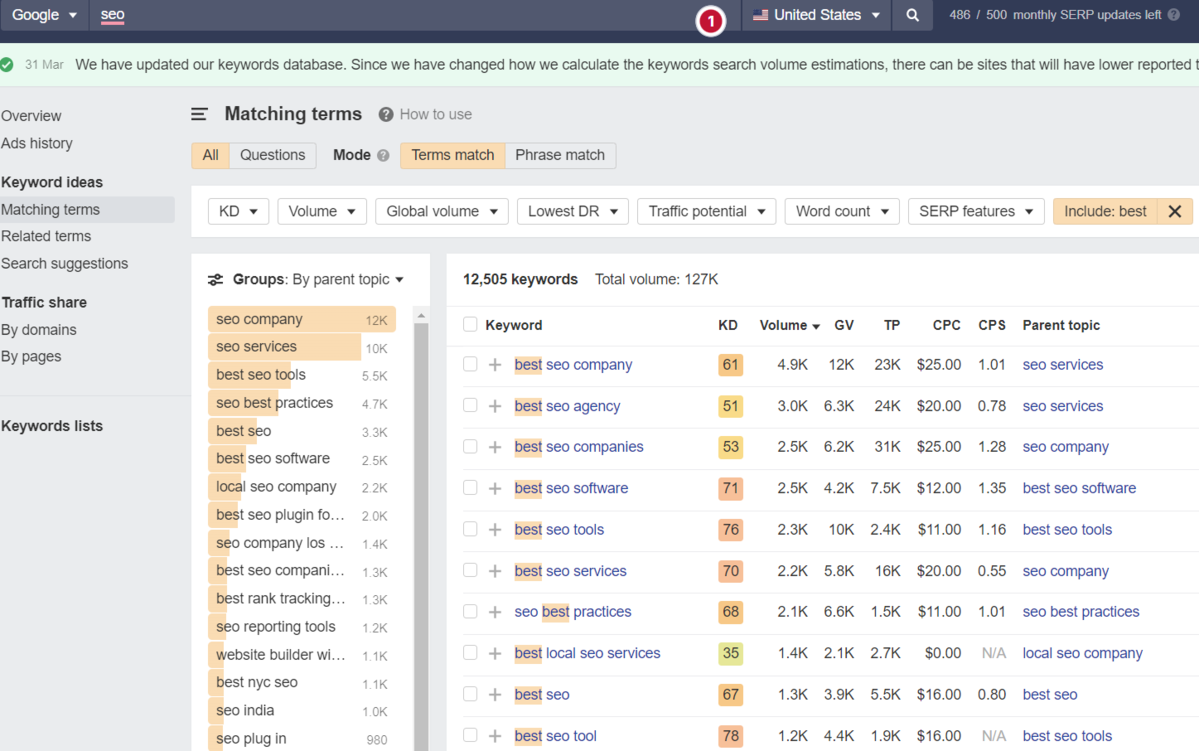 Screenshot from Ahrefs Keyword Explorer, March 2024
Screenshot from Ahrefs Keyword Explorer, March 2024
And unlike ChatGPT, generally, there is no token limit; you can extract several hundred, if not thousands, of keywords at a time.
As I have mentioned multiple times throughout this piece, you cannot blindly trust the data or SEO metrics it may attempt to provide you with.
The key is to validate the keyword research with a keyword research tool.
ChatGPT For International SEO Keyword Research
ChatGPT can be a terrific multilingual keyword research assistant.
For example, if you wanted to research keywords in a foreign language such as French. You could ask ChatGPT to translate your English keywords;
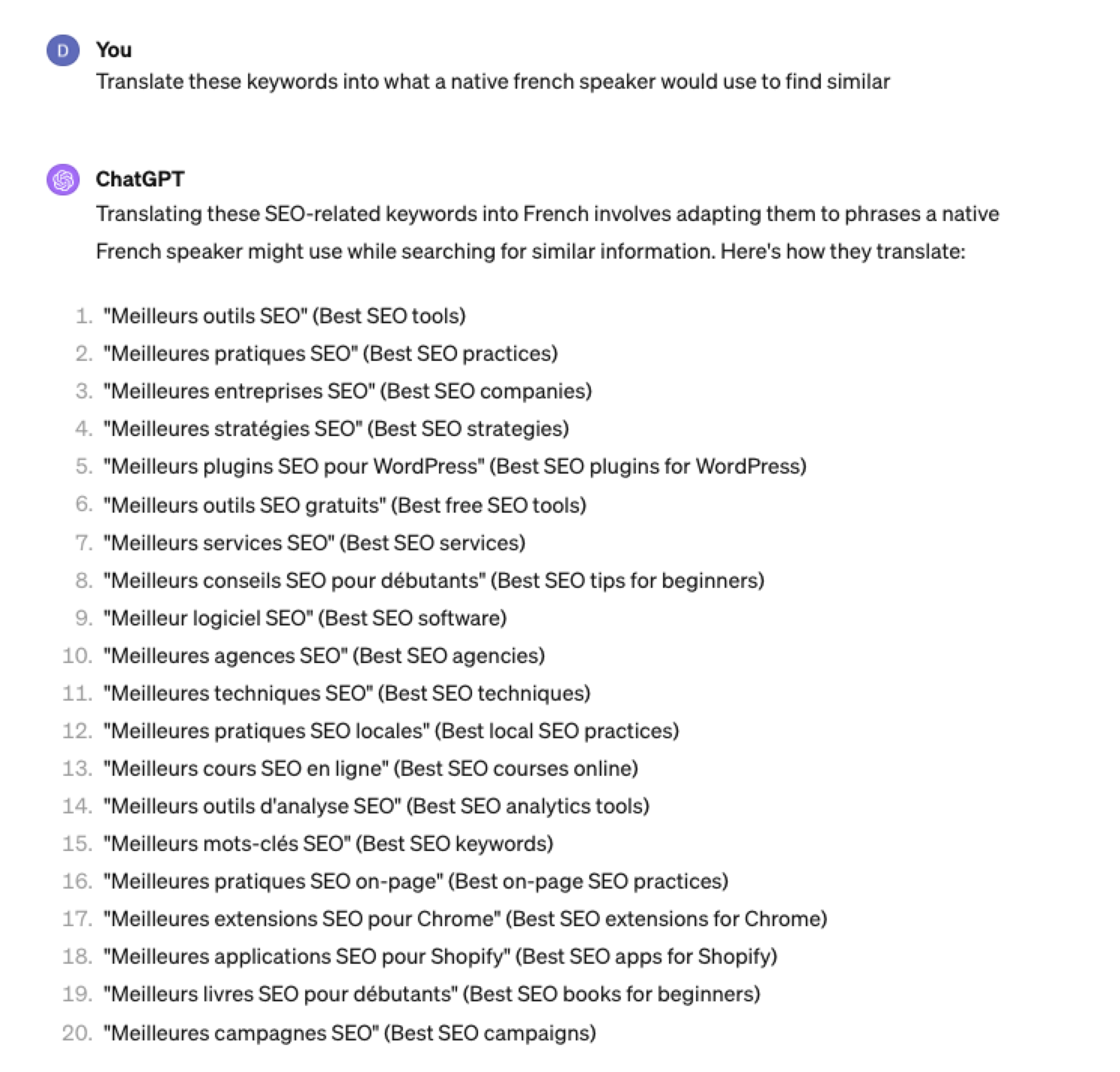 Screenshot ChatGPT 4, Apil 2024
Screenshot ChatGPT 4, Apil 2024- The key is to take the data above and paste it into a popular keyword research tool to verify.
- As you can see below, many of the keyword translations for the English keywords do not have any search volume for direct translations in French.
 Screenshot from Ahrefs Keyword Explorer, April 2024
Screenshot from Ahrefs Keyword Explorer, April 2024But don’t worry, there is a workaround: If you have access to a competitor keyword research tool, you can see what webpage is ranking for that query – and then identify the top keyword for that page based on the ChatGPT translated keywords that do have search volume.
-
-
 Screenshot from Ahrefs Keyword Explorer, April 2024
Screenshot from Ahrefs Keyword Explorer, April 2024
Or, if you don’t have access to a paid keyword research tool, you could always take the top-performing result, extract the page copy, and then ask ChatGPT what the primary keyword for the page is.
Key Takeaway
-
ChatGPT can be an expert on any topic and an invaluable keyword research tool. However, it is another tool to add to your toolbox when doing keyword research; it does not replace traditional keyword research tools.
As shown throughout this tutorial, from making up keywords at the beginning to inaccuracies around data and translations, ChatGPT can make mistakes when used for keyword research.
You cannot blindly trust the data you get back from ChatGPT.
However, it can offer a shortcut to understanding any topic for which you need to do keyword research and, as a result, save you countless hours.
But the key is how you prompt.
The prompts I shared with you above will help you understand a topic in minutes instead of hours and allow you to better seed keywords using keyword research tools.
It can even replace mundane keyword clustering tasks that you used to do with formulas in spreadsheets or generate ideas based on keywords you give it.
Paired with traditional keyword research tools, ChatGPT for keyword research can be a powerful tool in your arsenal.
More resources:
Featured Image: Tatiana Shepeleva/Shutterstock
SEO
OpenAI Expected to Integrate Real-Time Data In ChatGPT

Sam Altman, CEO of OpenAI, dispelled rumors that a new search engine would be announced on Monday, May 13. Recent deals have raised the expectation that OpenAI will announce the integration of real-time content from English, Spanish, and French publications into ChatGPT, complete with links to the original sources.
OpenAI Search Is Not Happening
Many competing search engines have tried and failed to challenge Google as the leading search engine. A new wave of hybrid generative AI search engines is currently trying to knock Google from the top spot with arguably very little success.
Sam Altman is on record saying that creating a search engine to compete against Google is not a viable approach. He suggested that technological disruption was the way to replace Google by changing the search paradigm altogether. The speculation that Altman is going to announce a me-too search engine on Monday never made sense given his recent history of dismissing the concept as a non-starter.
So perhaps it’s not a surprise that he recently ended the speculation by explicitly saying that he will not be announcing a search engine on Monday.
He tweeted:
“not gpt-5, not a search engine, but we’ve been hard at work on some new stuff we think people will love! feels like magic to me.”
“New Stuff” May Be Iterative Improvement
It’s quite likely that what’s going to be announced is iterative which means it improves ChatGPT but not replaces it. This fits into how Altman recently expressed his approach with ChatGPT.
He remarked:
“And it does kind of suck to ship a product that you’re embarrassed about, but it’s much better than the alternative. And in this case in particular, where I think we really owe it to society to deploy iteratively.
There could totally be things in the future that would change where we think iterative deployment isn’t such a good strategy, but it does feel like the current best approach that we have and I think we’ve gained a lot from from doing this and… hopefully the larger world has gained something too.”
Improving ChatGPT iteratively is Sam Altman’s preference and recent clues point to what those changes may be.
Recent Deals Contain Clues
OpenAI has been making deals with news media and User Generated Content publishers since December 2023. Mainstream media has reported these deals as being about licensing content for training large language models. But they overlooked a a key detail that we reported on last month which is that these deals give OpenAI access to real-time information that they stated will be used to give attribution to that real-time data in the form of links.
That means that ChatGPT users will gain the ability to access real-time news and to use that information creatively within ChatGPT.
Dotdash Meredith Deal
Dotdash Meredith (DDM) is the publisher of big brand publications such as Better Homes & Gardens, FOOD & WINE, InStyle, Investopedia, and People magazine. The deal that was announced goes way beyond using the content as training data. The deal is explicitly about surfacing the Dotdash Meredith content itself in ChatGPT.
The announcement stated:
“As part of the agreement, OpenAI will display content and links attributed to DDM in relevant ChatGPT responses. …This deal is a testament to the great work OpenAI is doing on both fronts to partner with creators and publishers and ensure a healthy Internet for the future.
Over 200 million Americans each month trust our content to help them make decisions, solve problems, find inspiration, and live fuller lives. This partnership delivers the best, most relevant content right to the heart of ChatGPT.”
A statement from OpenAI gives credibility to the speculation that OpenAI intends to directly show licensed third-party content as part of ChatGPT answers.
OpenAI explained:
“We’re thrilled to partner with Dotdash Meredith to bring its trusted brands to ChatGPT and to explore new approaches in advancing the publishing and marketing industries.”
Something that DDM also gets out of this deal is that OpenAI will enhance DDM’s in-house ad targeting in order show more tightly focused contextual advertising.
Le Monde And Prisa Media Deals
In March 2024 OpenAI announced a deal with two global media companies, Le Monde and Prisa Media. Le Monde is a French news publication and Prisa Media is a Spanish language multimedia company. The interesting aspects of these two deals is that it gives OpenAI access to real-time data in French and Spanish.
Prisa Media is a global Spanish language media company based in Madrid, Spain that is comprised of magazines, newspapers, podcasts, radio stations, and television networks. It’s reach extends from Spain to America. American media companies include publications in the United States, Argentina, Bolivia, Chile, Colombia, Costa Rica, Ecuador, Mexico, and Panama. That is a massive amount of real-time information in addition to a massive audience of millions.
OpenAI explicitly announced that the purpose of this deal was to bring this content directly to ChatGPT users.
The announcement explained:
“We are continually making improvements to ChatGPT and are supporting the essential role of the news industry in delivering real-time, authoritative information to users. …Our partnerships will enable ChatGPT users to engage with Le Monde and Prisa Media’s high-quality content on recent events in ChatGPT, and their content will also contribute to the training of our models.”
That deal is not just about training data. It’s about bringing current events data to ChatGPT users.
The announcement elaborated in more detail:
“…our goal is to enable ChatGPT users around the world to connect with the news in new ways that are interactive and insightful.”
As noted in our April 30th article that revealed that OpenAI will show links in ChatGPT, OpenAI intends to show third party content with links to that content.
OpenAI commented on the purpose of the Le Monde and Prisa Media partnership:
“Over the coming months, ChatGPT users will be able to interact with relevant news content from these publishers through select summaries with attribution and enhanced links to the original articles, giving users the ability to access additional information or related articles from their news sites.”
There are additional deals with other groups like The Financial Times which also stress that this deal will result in a new ChatGPT feature that will allow users to interact with real-time news and current events .
OpenAI’s Monday May 13 Announcement
There are many clues that the announcement on Monday will be that ChatGPT users will gain the ability to interact with content about current events. This fits into the terms of recent deals with news media organizations. There may be other features announced as well but this part is something that there are many clues pointing to.
Watch Altman’s interview at Stanford University
Featured Image by Shutterstock/photosince
-

 PPC5 days ago
PPC5 days agoHow the TikTok Algorithm Works in 2024 (+9 Ways to Go Viral)
-

 MARKETING7 days ago
MARKETING7 days agoA Recap of Everything Marketers & Advertisers Need to Know
-

 SEO6 days ago
SEO6 days agoBlog Post Checklist: Check All Prior to Hitting “Publish”
-

 SEO4 days ago
SEO4 days agoHow to Use Keywords for SEO: The Complete Beginner’s Guide
-

 MARKETING5 days ago
MARKETING5 days agoHow To Protect Your People and Brand
-

 PPC6 days ago
PPC6 days agoHow to Craft Compelling Google Ads for eCommerce
-

 SEARCHENGINES6 days ago
SEARCHENGINES6 days agoGoogle Started Enforcing The Site Reputation Abuse Policy
-

 MARKETING4 days ago
MARKETING4 days agoThe Ultimate Guide to Email Marketing


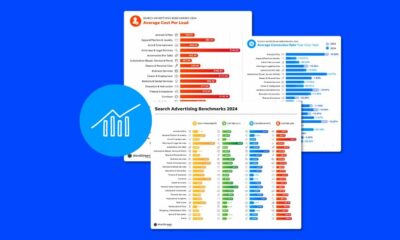

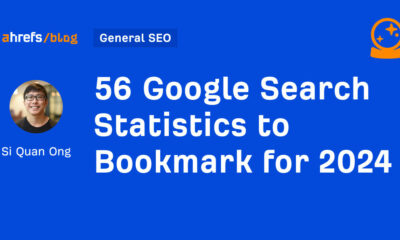







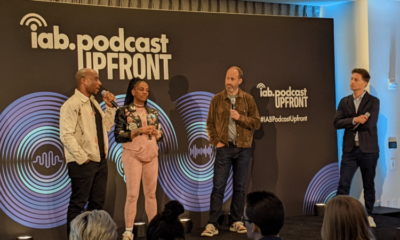



You must be logged in to post a comment Login